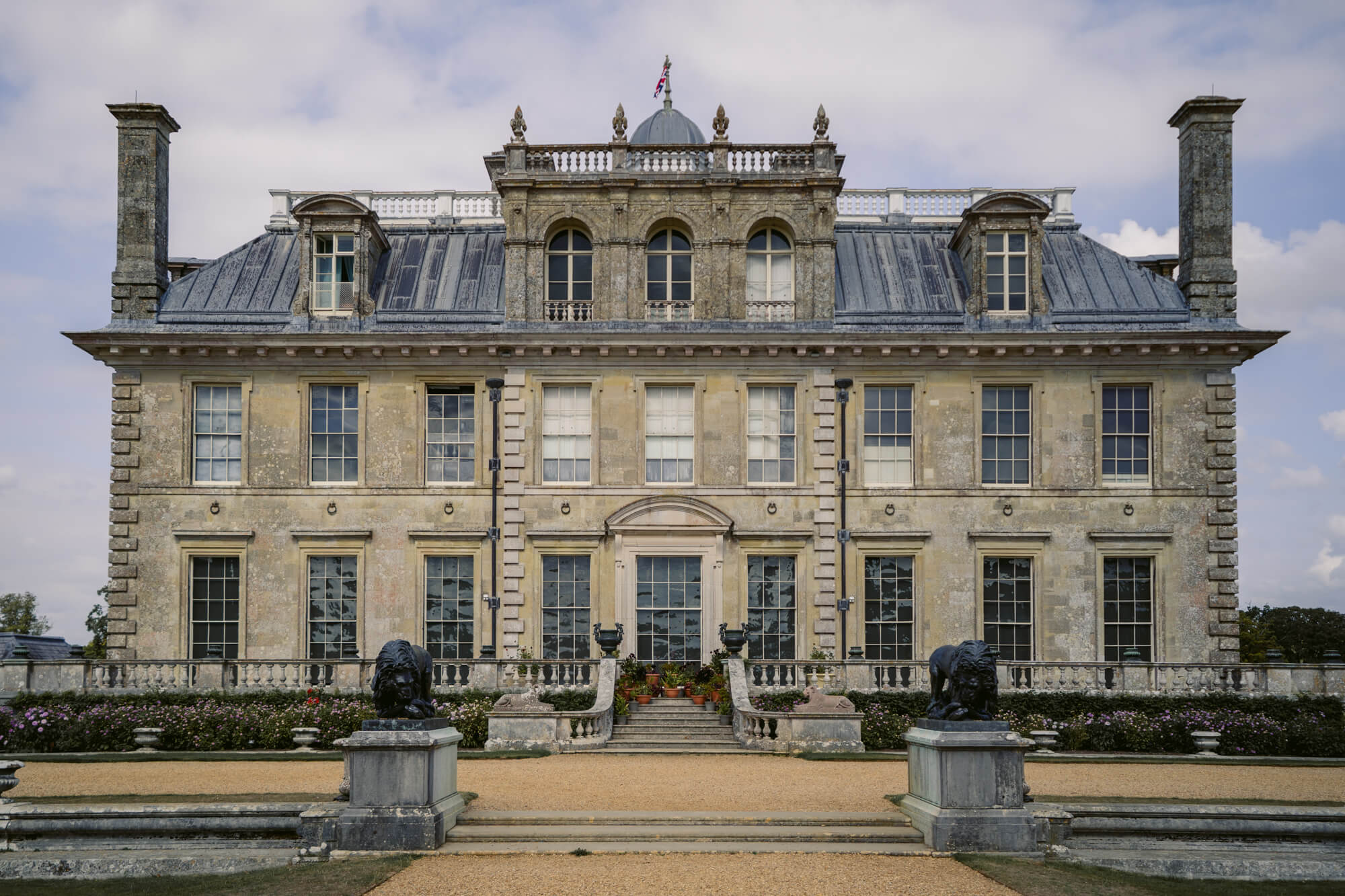*FYI - this post may contain affiliate links, which means we earn a commission at no extra cost to you if you purchase from them. Also, as an Amazon Associate I earn from qualifying purchases. Check out our Privacy Policy and Disclosure for more info.
Kingston Lacy is a stunning National Trust property located in the Dorset countryside that is famed for its sprawling estate and gardens, opulent Italianate manor house, and impressive collection of art and antiquities.
Owned by the ultra-wealthy Bankes family since the 17th century, Kingston Lacy has undergone several makeovers over the years, most notably in the mid 19th century, when adventurer William John Bankes spearheaded redesigns and renovations to turn the home into his Italian-inspired dream house.
He continued to redesign the space even after his forced exile in 1841, when he fled for Italy to avoid persecution (and likely execution) for being gay, and much of the house’s current appearance is owed to his taste and vision… even if much of the work was done remotely.
Luckily for visitors like you and me, these days the collection, house, and grounds is open for public exploration, with plenty of fun things to do that make for a great day out.
So whether you’re planning your own Kingston Lacy trip, or simply curious about what to expect, we’re here to help.
In this Kingston Lacy guide, we’ll be covering all of the following:
- Practical Info for Visiting Kingston Lacy
- A Brief History of Kingston Lacy
- How to Get to Kingston Lacy
- Things to do at Kingston Lacy
- Inside Kingston Lacy House
- Additional Tips for Visiting Kingston Lacy
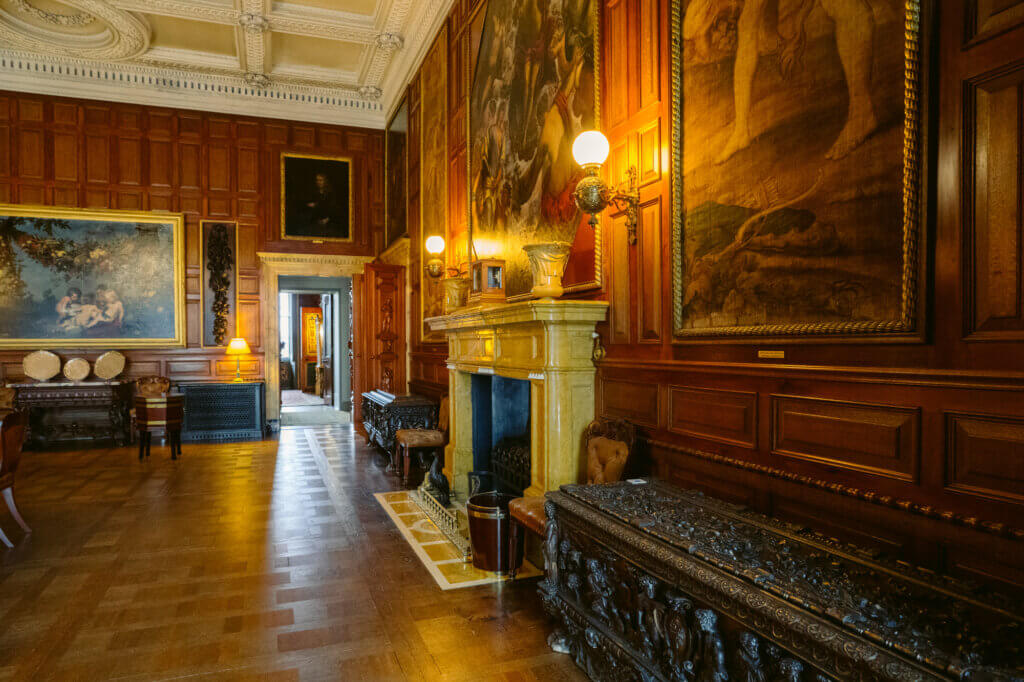
Practical Info for Visiting Kingston Lacy
Looking for a quick scoop on everything you need to know for your Kingston Lacy visit? Take note of the following…
Kingston Lacy Opening Times
As of September 2022, these were the opening hours for the various sites around Kingston Lacy. Do note that this may change seasonally or dependent on special events, so be sure to check the official website here for the most up-to-date Kingston Lacy opening times.
| House | 10:30 – 15:00 |
| Car Park | 09:30 – 17:00 |
| Garden | 09:30 – 17:00 |
| Park | 09:30 – 17:00 |
| Stables Cafe | 10:00 – 17:00 |
| Shop | 10:00 – 17:00 |
| Second Hand Bookshop | 10:00 – 17:00 |
| Badbury Rings Car Park | Dawn to Dusk |
| Kitchen Garden Kiosk | 10:00 – 16:00 |
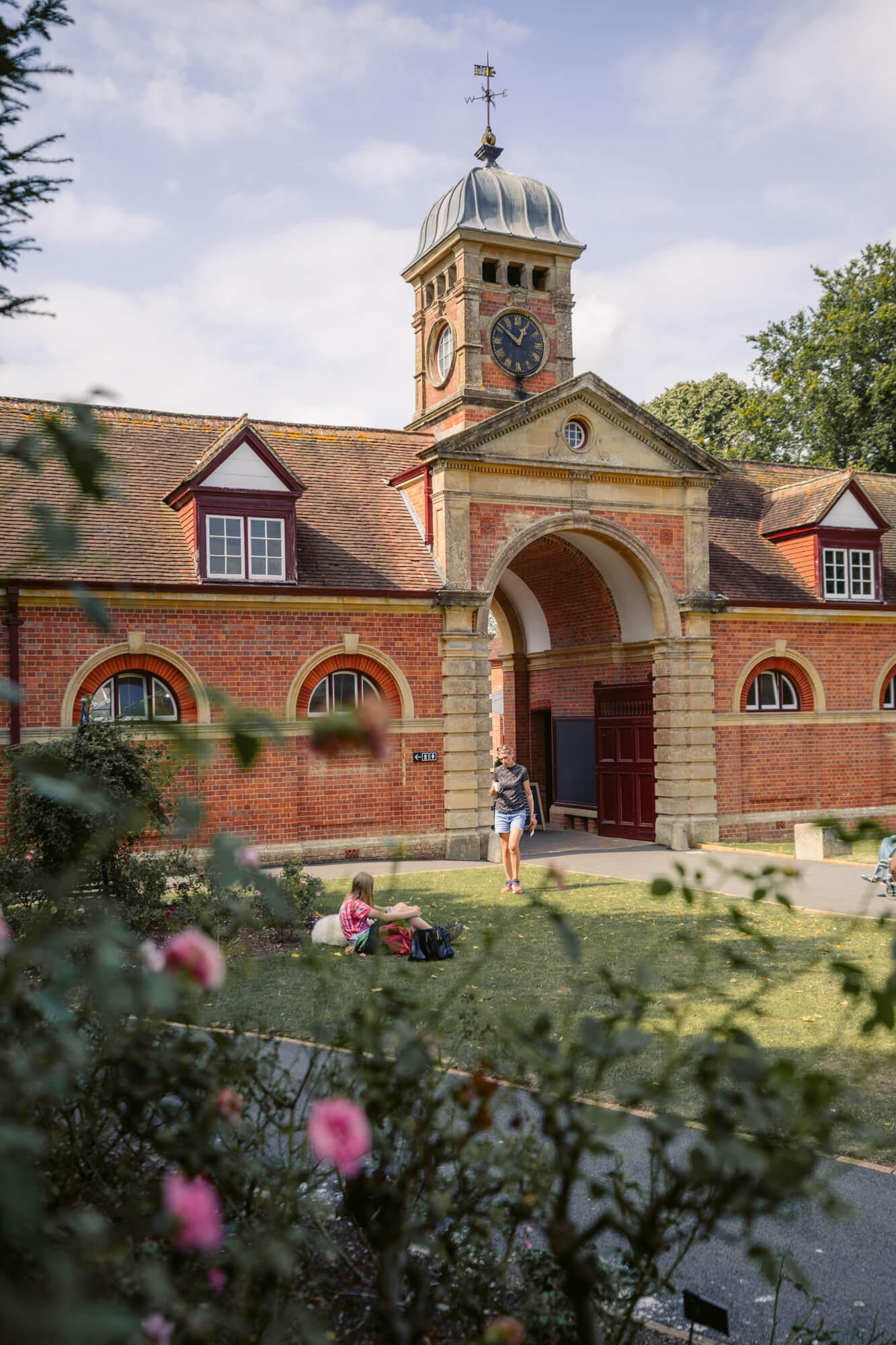
Kingston Lacy Ticket Prices
As of September 2022, the prices for Kingston Lacy are as follows:
| Gift Aid | Standard | |
| Adult | £19.80 | £18.00 |
| Child | £9.90 | £9.00 |
| Family | £49.50 | £45.00 |
| 1 Adult, 2 Children | £29.70 | £27.00 |
| Group Adult | N/A | £15.00 |
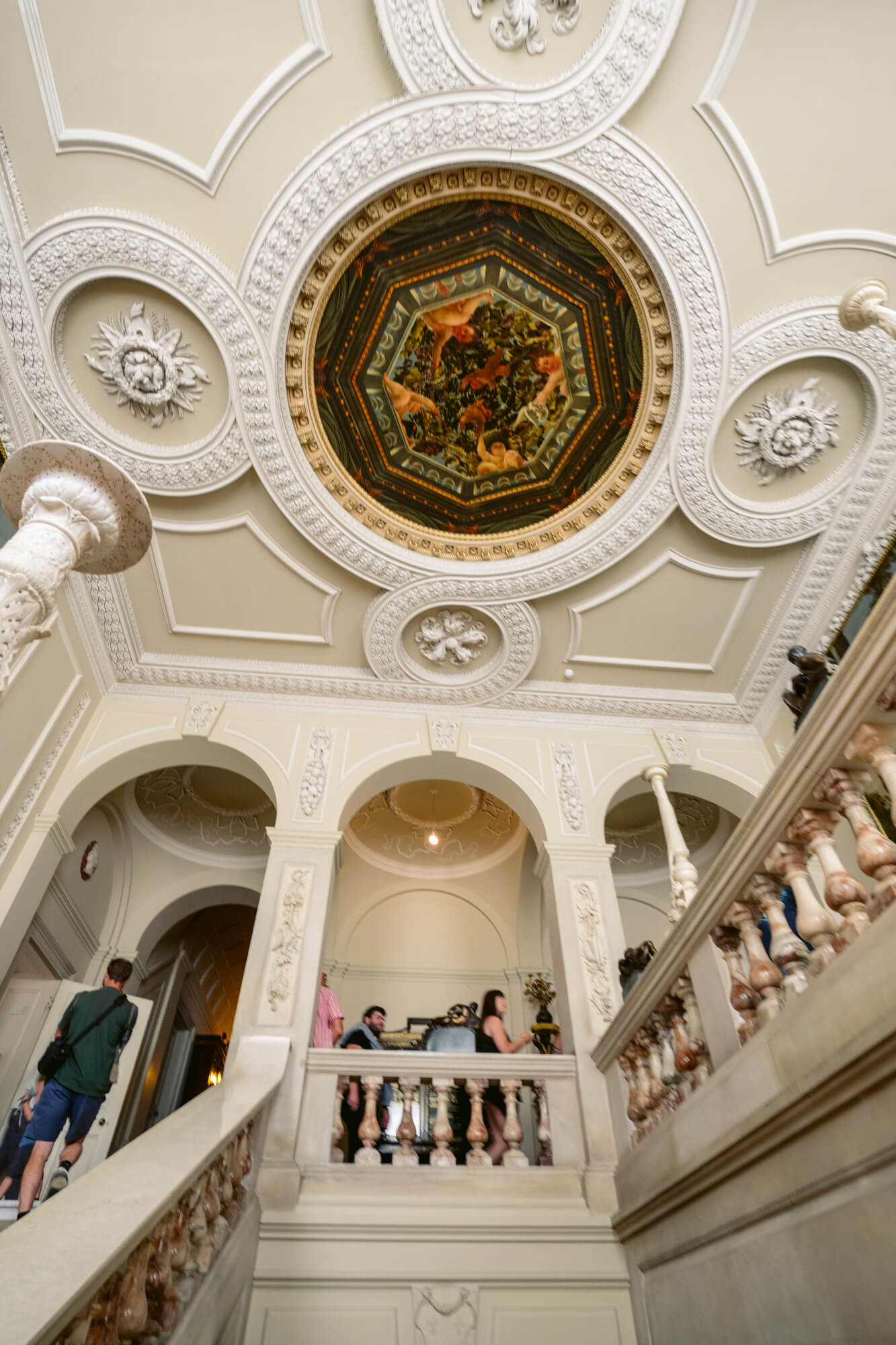
Parking at Kingston Lacy & How to Get There
Public transportation to Kingston Lacy is only available on certain days, from Wimborne Minster.
According to the official National Trust website, on Tuesdays, Thursdays and Fridays, you can catch the Local Bus Service 88 from Wimborne to Kingston Lacy car park.
Undoubtedly, the best way to reach Kingston Lacy is by car. Follow along B3082 Blandford to Wimborne road and then follow the brown signs for Kingston Lacy.
There is no additional fee for parking at the main Kingston Lacy parking lot, but non-members parking at the Badbury Rings must pay £1 for two hours or £3 for the day. National Trust members can park at Badbury Rings for free.
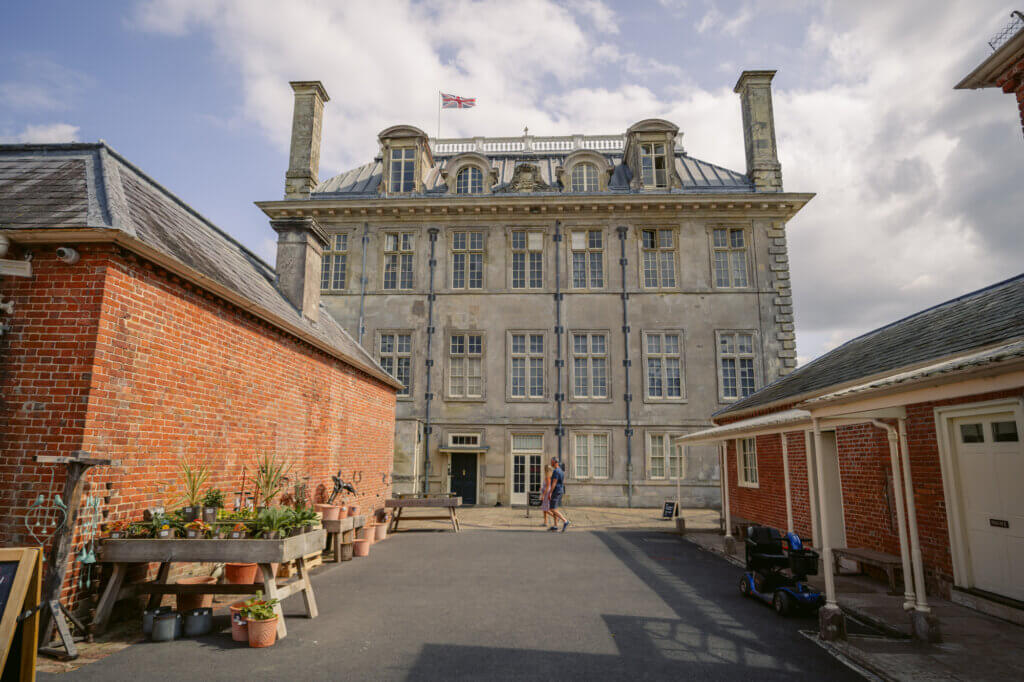
Accommodation
Looking for somewhere to stay nearby? Here are some recommendations:
- Budget: Check reviews and availability
- Mid-Range: Check reviews and availability
- Luxury: Check reviews and availability
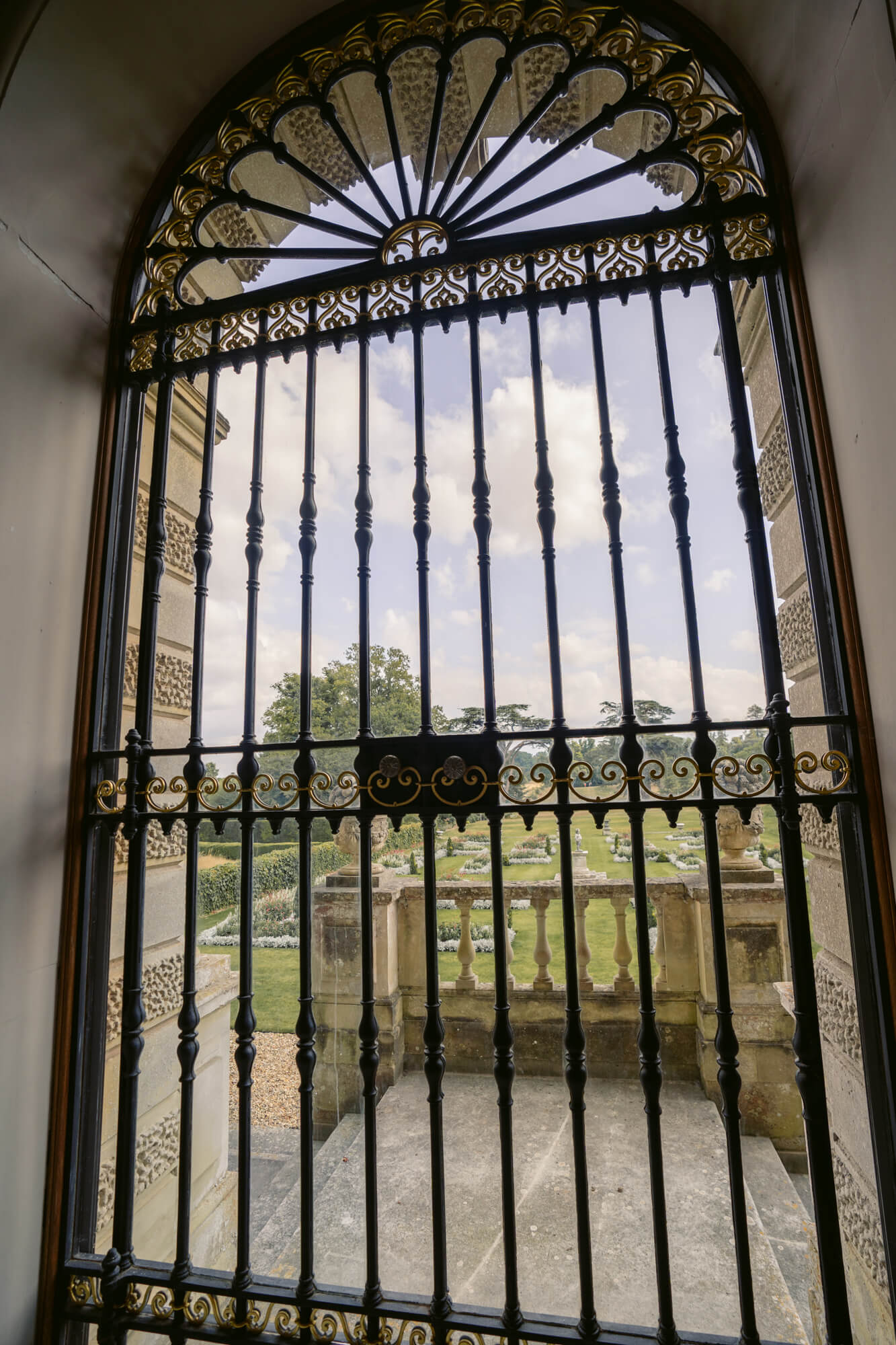
A Brief History of Kingston Lacy
It is said that an estate has existed in the area of Kingston Lacy since Saxon times, with a number of well-to-do tenants over the years, including Dukes and Earls like those of the de Lacy family (who gave the estate the second half of its name).
It’s not until 1636 that the story really gets interesting though, because it was in that year that the estate was sold to Sir John Bankes, attorney general (and later Chief Justice) to King Charles I. In case you’re wondering how rich he was, this is the fella who also owned Corfe Castle (where the family lived), in addition to large swaths of land around Dorset like in Studland.
Sadly, Sir John Bankes was made Chief Justice of the Common Pleas in 1640, and ditched his family to join King Charles I, dying soon after in 1644. This left his wife, Lady Mary Bankes, alone to defend the family home at Corfe Castle through not one, but two sieges during the English Civil Wars.
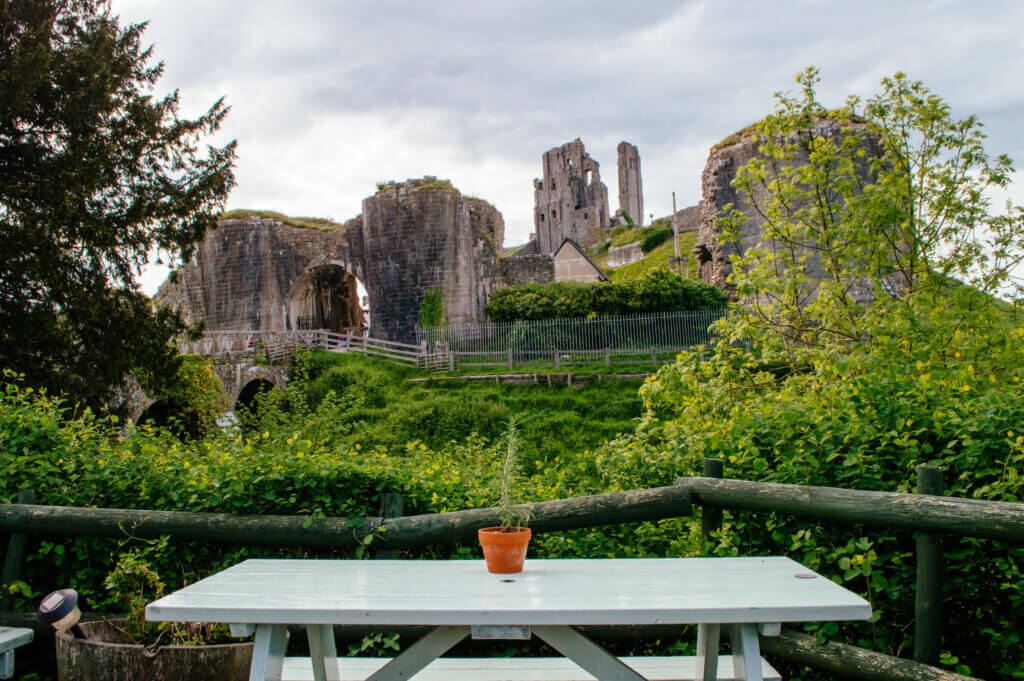
It wasn’t until one of her own men betrayed her that she had to give the castle up, and it is said that her fortitude was so impressive even to her enemies, that she was given the keys to the castle before she left. By 1645, the Parliamentarians had won the war, King Charles I had been executed, and Corfe Castle was deliberately destroyed and in ruins.
Anyways, fast forward a few years – after the monarchy was restored in England, the Bankes family was given their properties back. Left without the family castle (RIP, Corfe), Sir Ralph Bankes had a house built on the Kingston Lacy estate from 1663-1665. This was more or less the start of the property as we know it now.
Of course, as with any family home, it has been redone, remodelled, and renovated over the centuries according to changes in taste and styles. Here are some of the more notable Bankes that lived at Kingston Lacy, and their impact on the property:
- Sir Ralph Bankes (second son of Sir John and Lady Mary), who got the estate after his dad and older brother died and had the house built from 1663 – 1665, although at this time it was made of red brick
- John Bankes III (AKA John Bankes the Elder), son of Sir Ralph Bankes, who (supposedly) accidentally shot himself to death at the age of 49
- Henry Bankes the Younger, who added a ballroom and acquired some more land for the family
- William John Bankes, son of Henry Bankes the Younger, who hired rockstar architect Charles Barry to do some renos (including encasing the house in the present day stone) and is largely responsible for the way the property looks today – treasures from around the world, and all
- George Bankes, William John’s brother who managed the estate after his exile, and whose grandson Walter (alongside his wife Henrietta) would build the stables, add the Japanese Garden, and deck out the Kitchen Garden as well
- Henry John Ralph Bankes (son of Walter and Henrietta), who inherited the estate at the age of 21, then bequeathed everything (including Kingston Lacy, Corfe Castle, and the rest of the family’s 16,000 acres of land) to the National Trust upon his death in 1981, the largest donation ever received by NT
And so, after centuries of modifications at the hands of several generations of Bankes, Kingston Lacy stands as one of the most beautiful National Trust properties in Southern England.
There are far more stories to be told, but for the sake of brevity, we’ll end it here. Be sure to chat with the volunteers during your visit though to hear more about the property’s fascinating history!
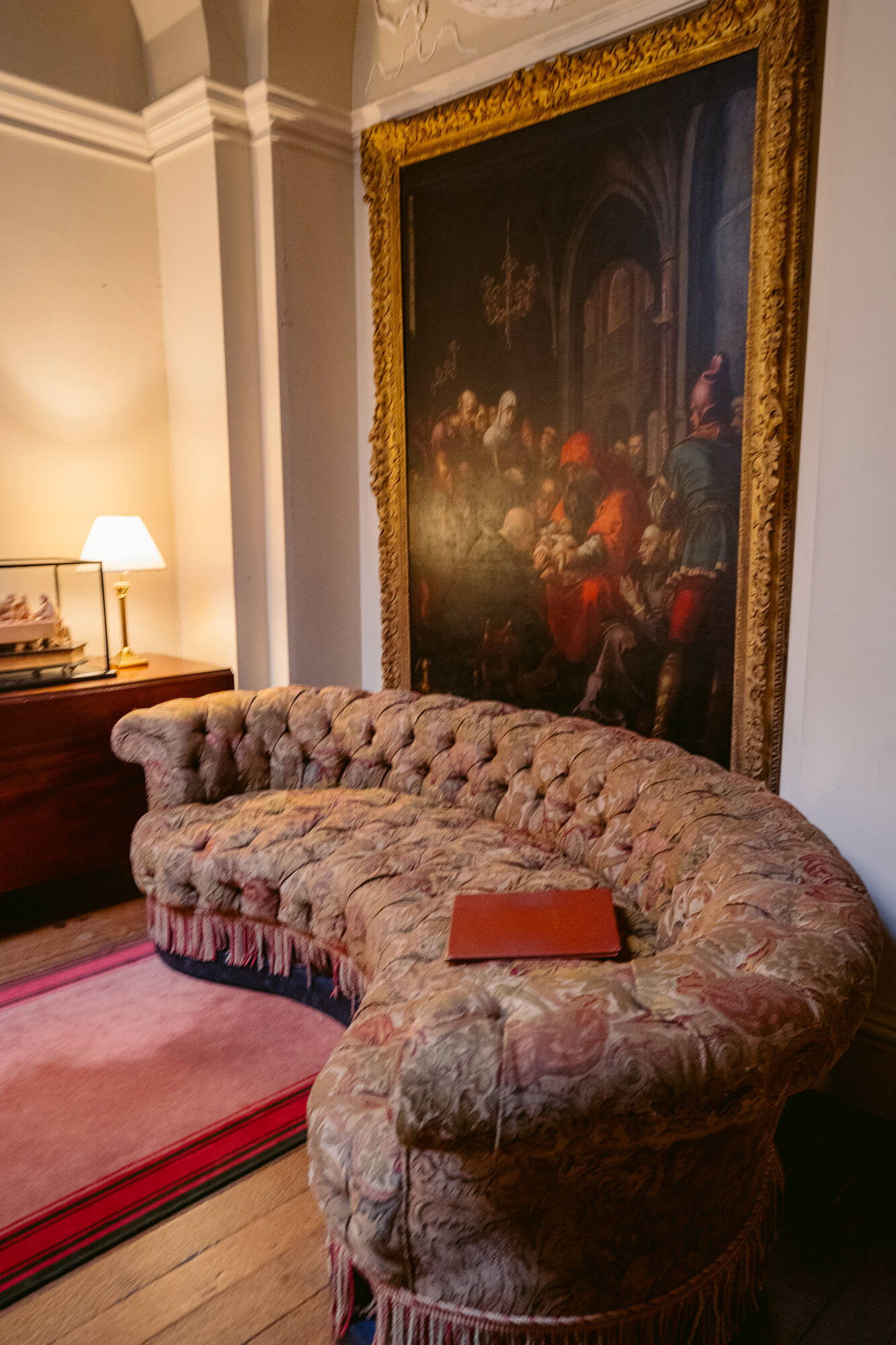
Things to Do at Kingston Lacy
Wondering what you can do at the Kingston Lacy estate? Here are some of the most popular options.
Take a peek inside Kingston Lacy House
Of course, the starring attraction at Kingston Lacy is Kingston Lacy House, which offers visitors a chance to dive into the opulent world of the Bankes family, whose house (particularly the parts redesigned by William John) is more akin to a European palace than a Dorset countryside home.
There are several floors (including the attic) open to the public, and we were lucky enough to see them all, although we’ve heard that from time to time, there may be restrictions due to a lack of staff.
While exploring the many rooms of the House, be sure to ask questions of the (very knowledgable) volunteers, who take time to point out significant items from the estate’s extensive collection, which has over 13,000 different items.
You can see the collection online here as well.
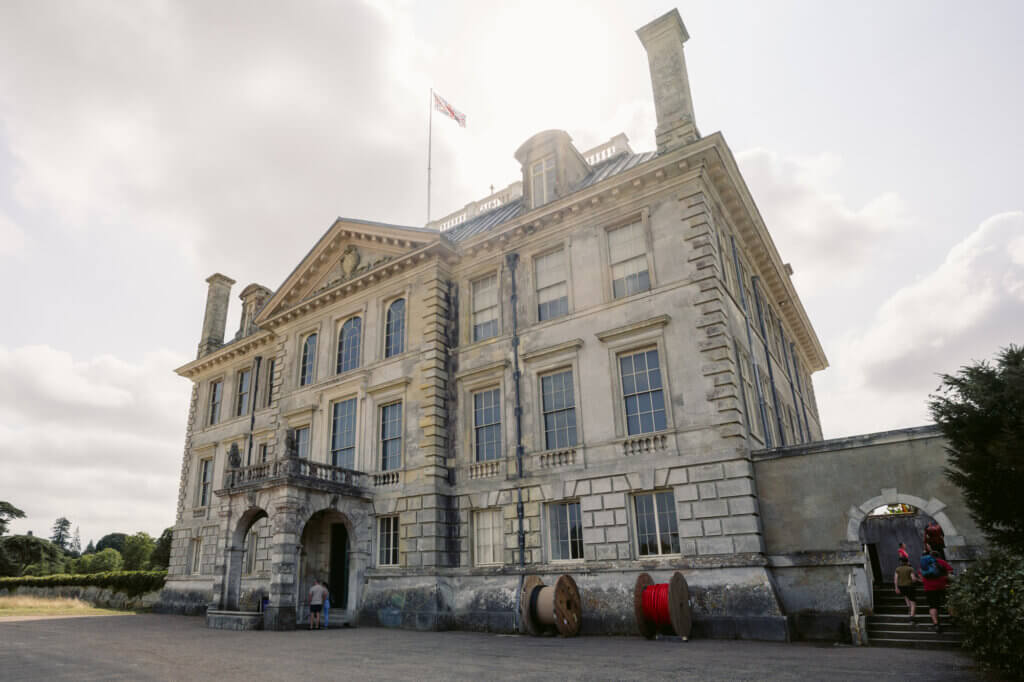
Visit the Japanese Gardens
Created in the early 20th century, another highlight of the Kingston Lacy grounds is the Japanese Garden which spans seven acres.
Complete with an authentic Japanese tea house, this picture perfect garden is worth visiting any time of year, with each season bringing a unique treat – from cherry blossoms in the Spring and Japanese maples in the Autumn, all the way to over 40 types of snowdrops in the winter.
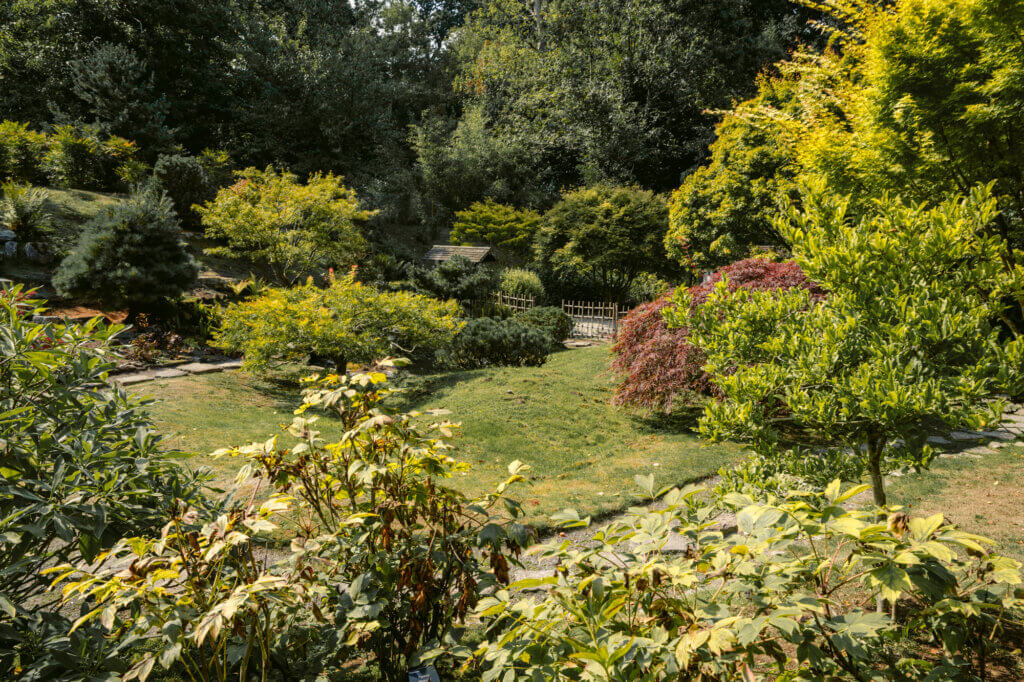
Peruse the Second Hand Bookshop
Located in the estate’s main courtyard, the Second Hand Bookshop is one of the first sights to greet you as you exit Kingston Lacy House.
All proceeds from book sales go towards garden conservation projects, which offers a great reason to stop by and grab a book or two from their extensive collection of second hand books for all genres and audiences, assembled via generous donations from the public.
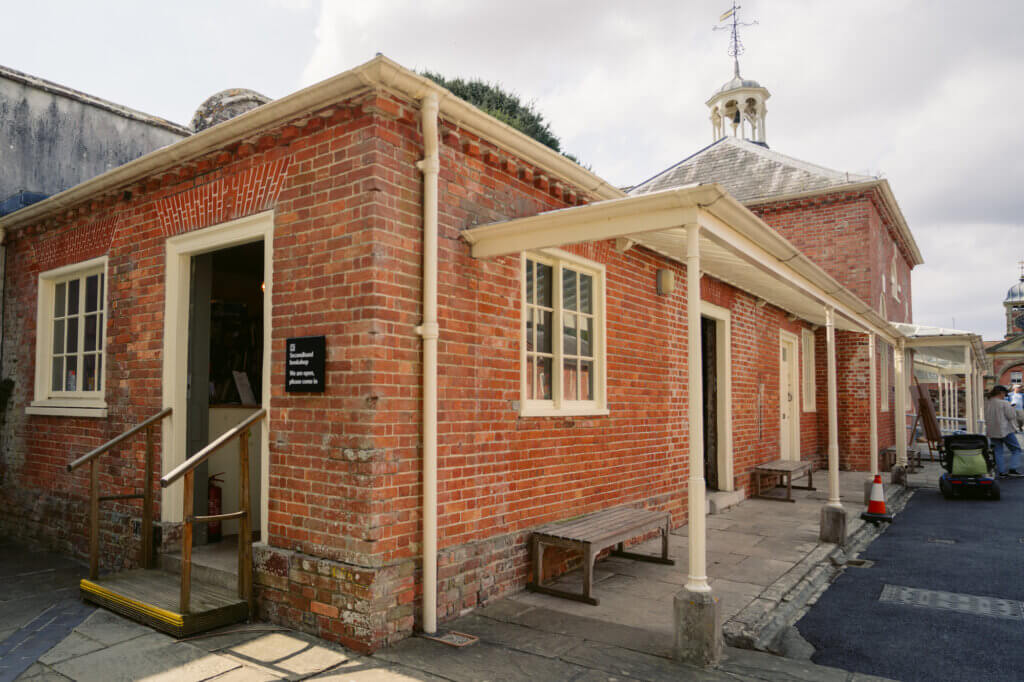
Go for a long walk around the Estate
Encompassing 8,500 acres, the Kingston Lacy estate is truly massive, and there are a variety of great walks to enjoy. Be sure to grab a map from the volunteers at the entrance so you can find your way around!
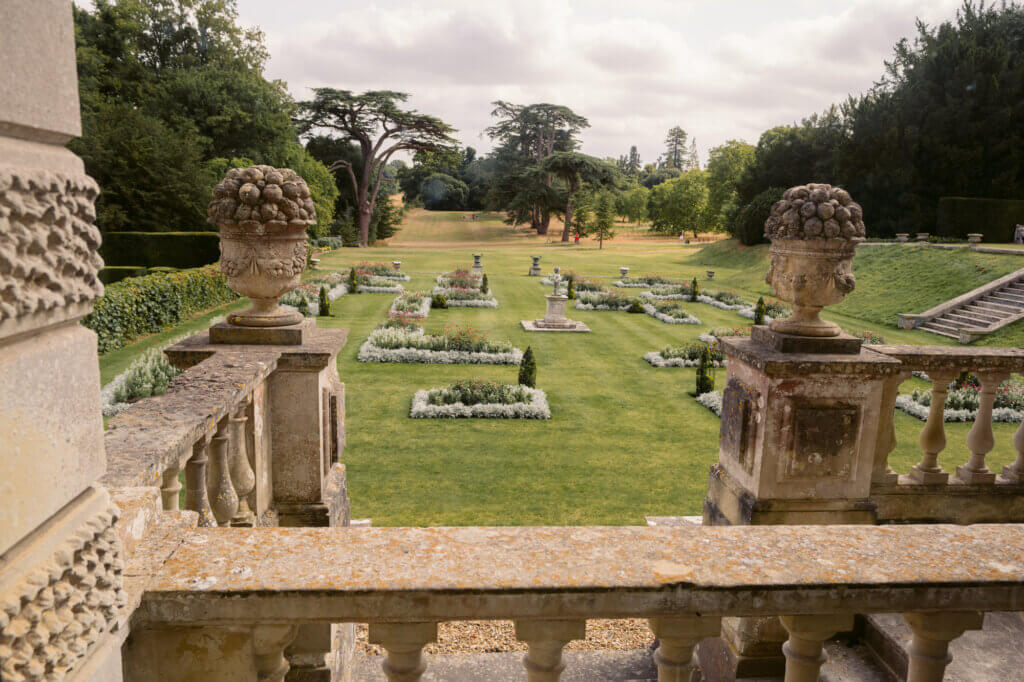
Explore the Badbury Rings
Perched 100m above sea level, the Badbury Rings are what remain of an Iron Age hillfort that dates all the way back to the year 800BC. These days, it’s a beautiful place for a stroll, with lovely views over the Kingston Lacy estate and beyond.
BONUS: Attend ‘Christmas at Kingston Lacy’
Lastly, if you time your Kingston Lacy visit with the holidays, you’ll be treated to a festive display containing over a million lights and gorgeous installations that are guaranteed to get you in the Christmas spirit.
NOTE: An additional fee does apply even for National Trust members.
Inside Kingston Lacy House
Wondering what the individual rooms look like inside Kingston Lacy House? Here is a little virtual tour to show you!
Entrance Hall
When you first enter Kingston Lacy, you are in the (present day) entrance hall. While once upon a time, this would have been the cellar, it was modifications made by William John Bankes in the 19th century that made it look as it does today, with its creamy stone columns and eye-catching fireplace.
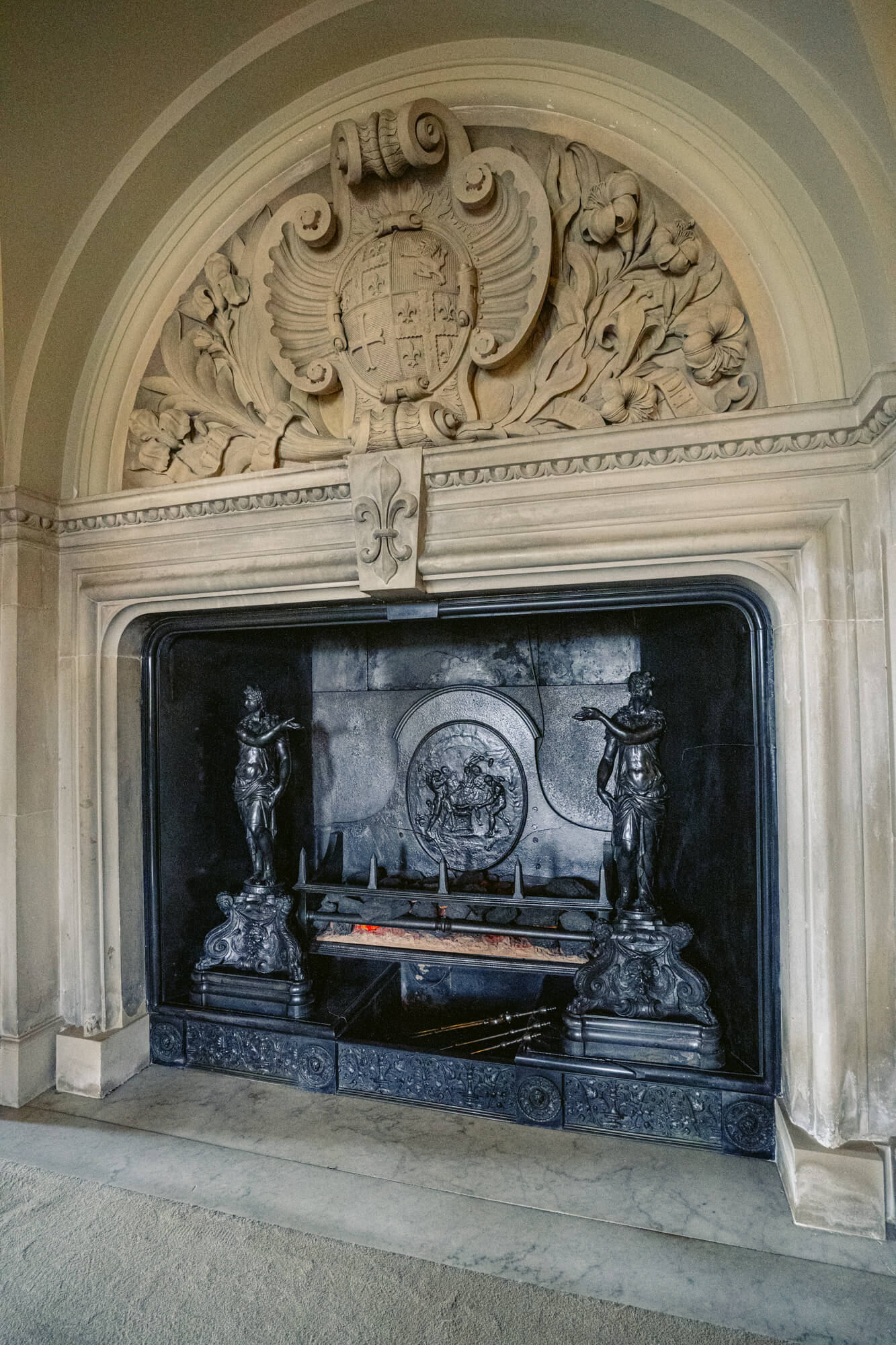
Marble Staircase and Loggia
As you move up the marble staircase (said to be modelled after the staircase belonging to Palazzo Ruspoli in Rome), you see a few bronze statues made of some of the most notable members of the Bankes family, including Lady Mary.
Head up the stairs, follow the signs, and you’ll soon find yourself in your first room: the Library.
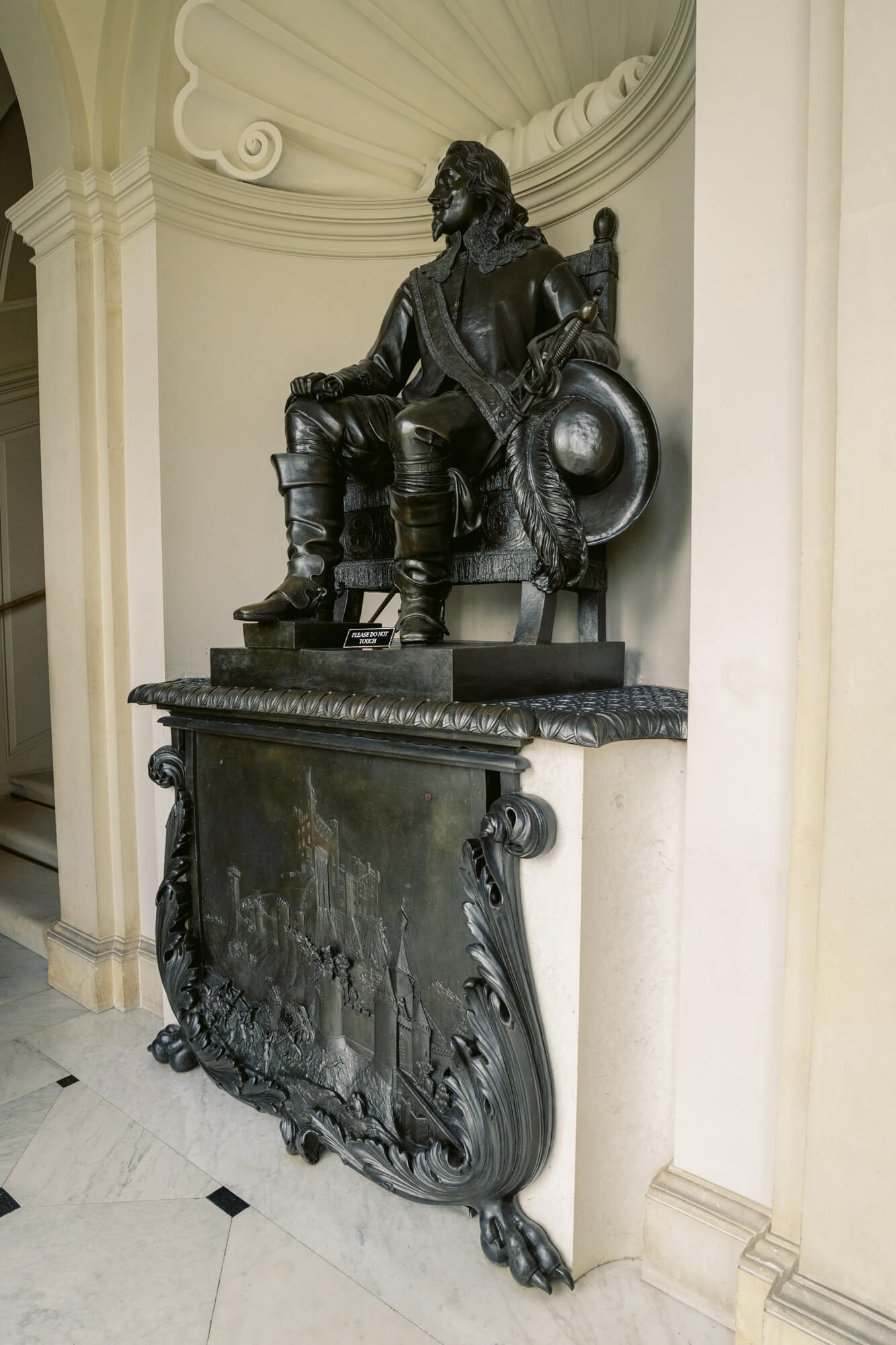
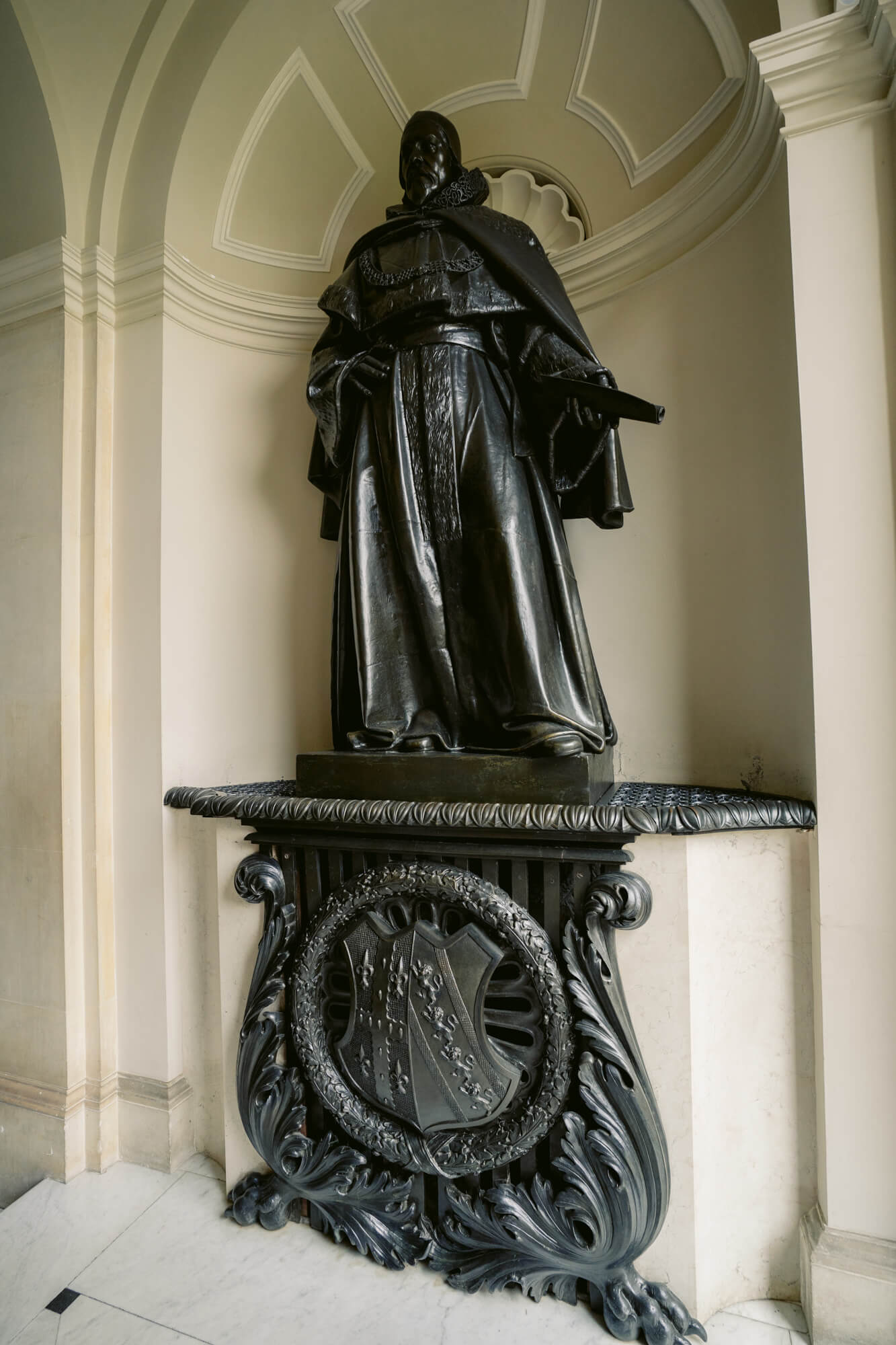
The Library
Containing the National Trust’s largest collection of early books, this beautiful cozy library is home to over 2500 books, predominantly from the 17th century.
Some noteworthy details include the ceiling fresco, originally painted on a domed ceiling in an Italian palazzo, then meticulously (and riskily) transferred over to Kingston Lacy, as well as the keys which hang above the mantlepiece. It is said that these keys are originals that were taken from Corfe Castle prior to its ruin during the English Civil War.
And if you’re curious about the family who owned this glamorous house, then this is a great room to indulge your curiosity as you can simply look on the walls!
Around the library, you’ll find a statue of Lady Mary Bankes holding a key and sword (a reference to her defense of Corfe Castle), along with a painting of Sir John Bankes on the window wall, and other paintings of the Bankes children.
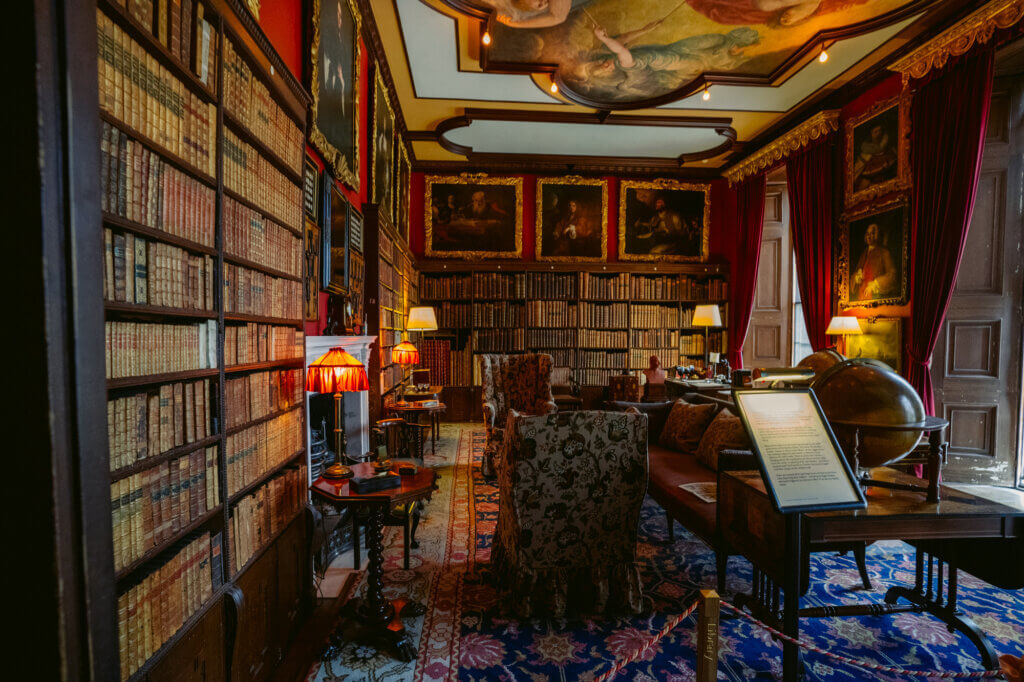
The Drawing Room
While this room once served as a Great Parlour back in the days of Sir Ralph Bankes (who was, as you’ll recall, the one who had the house built), it was redesigned in the 1780s by Henry Bankes the Younger and his (beautiful) wife Frances, whose portrait can be seen hanging on the room’s right wall.
Most notable in this room is probably the modest looking grand piano, which was actually one of the first grand pianos to be manufactured in the country.
There’s also a set of unique vases explicitly made for displaying tulips, a rare and expensive commodity back in the day.
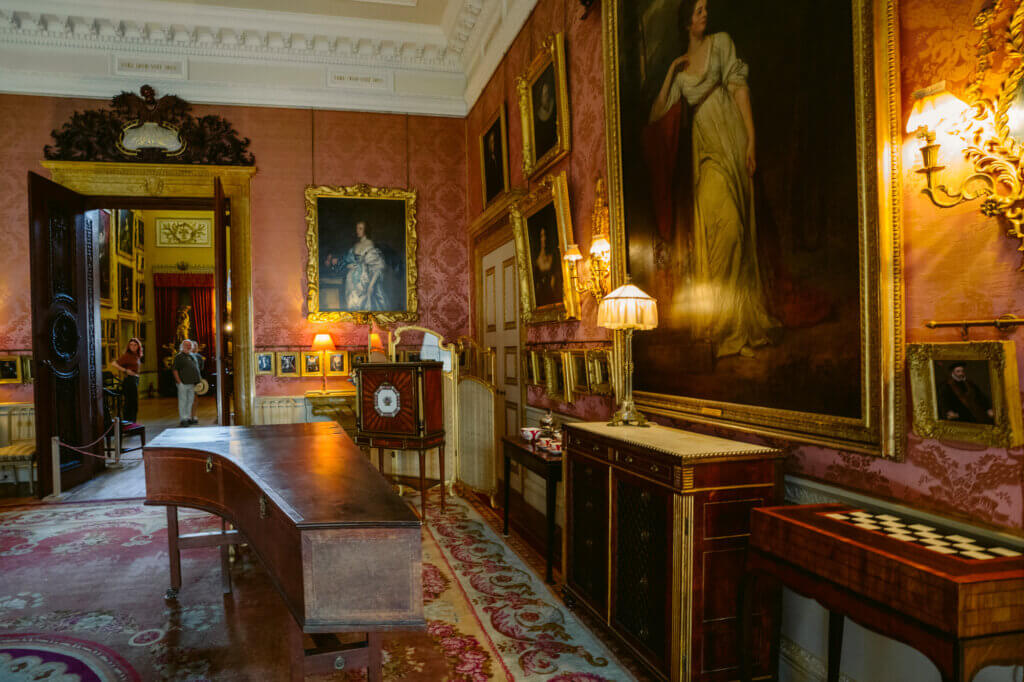
The Dining Room
While it was originally a suite of rooms that included a staircase, this room was converted into a State Dining Room by William John in the 1830s. Internal walls were removed to enlarge the space, while an organ was moved in from the Saloon.
Some highlights in this beautiful room include the intricately carved boxwood doors (which were supposedly carved in Venice), and walnut shutters that were actually designed by William John.
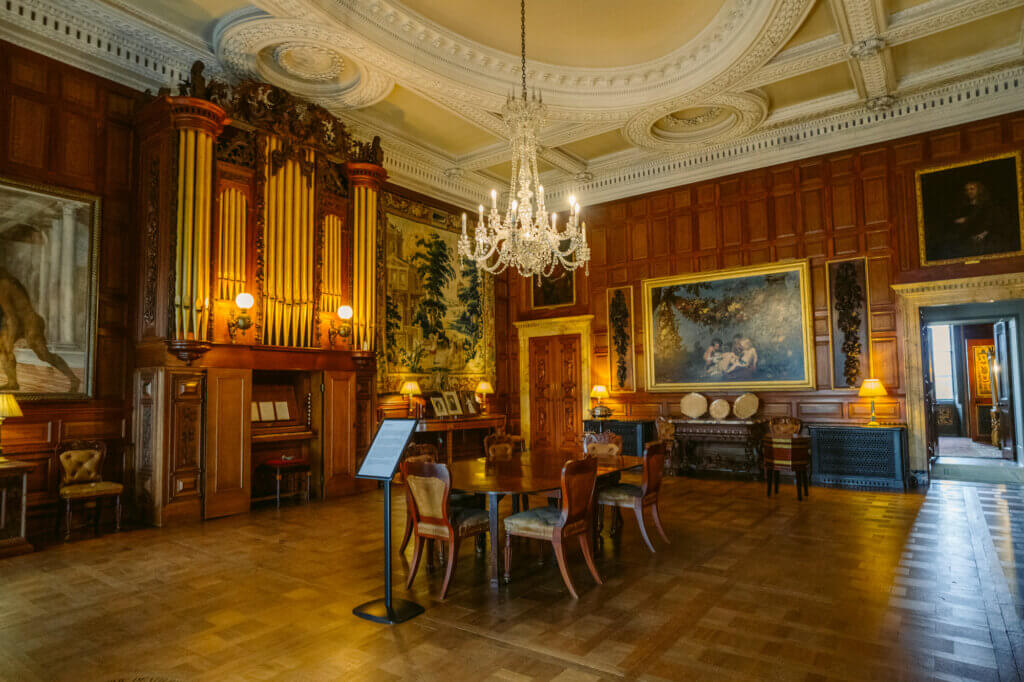
The Spanish Room
The most extravagant room at Kingston Lacy is by far The Spanish Room, and probably William John’s finest work, made all the more impressive by the fact that it was mostly redone remotely, with William John sending detailed instructions and designs from his exile post in Venice.
There’s gilded ceilings with elaborate paintings (originally thought to have come from Venice, but later were found to be copies), leather-bound walls, and 12 beautiful door panels designed by William John himself. Each one depicts a different month in gorgeous detail, and they’re really quite exceptional to look at!
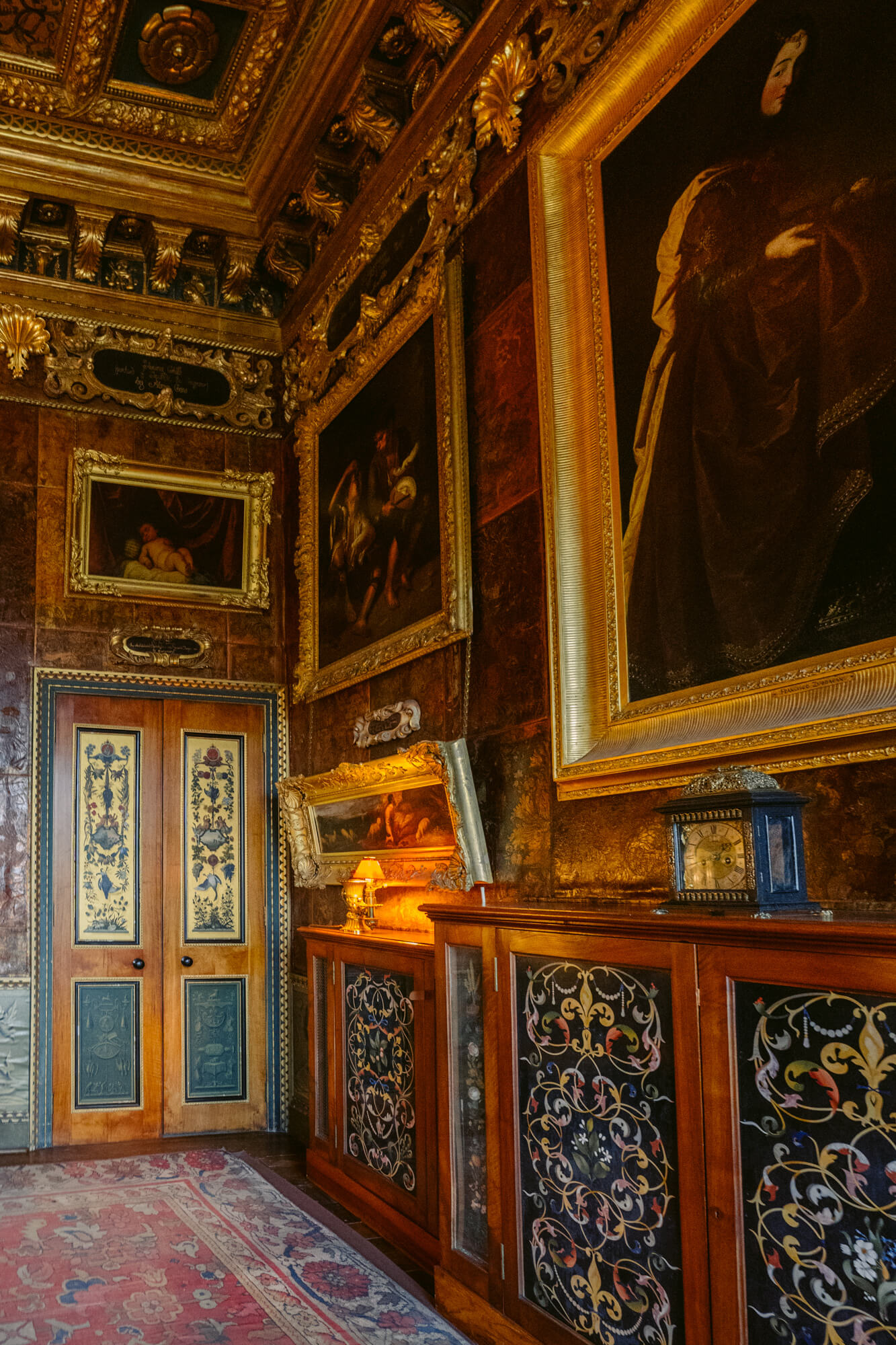
True to its name, this room is adorned with all kinds of Spanish paintings, which (we were told) came much cheaper than the Italian paintings that were in fashion at the time.
Hands down, this is the room at Kingston Lacy with the most wow factor, so be sure to take it all in and enjoy, because that’s sadly a privilege that William John himself never had, as he died in exile without seeing the completed room.
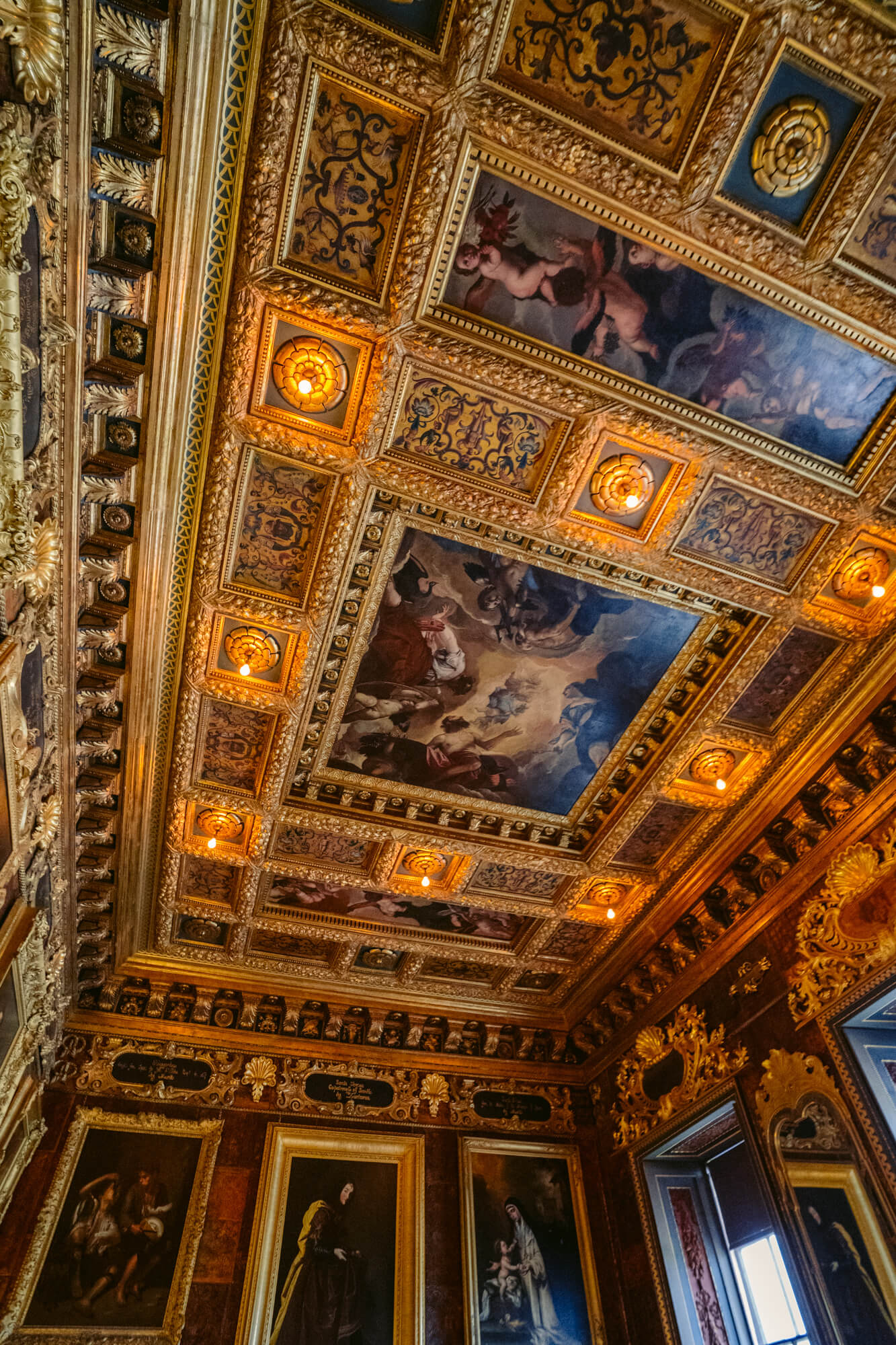
The Saloon
Stepping into the Kingston Lacy Saloon, the main highlight is the variety of beautiful paintings adorning the walls.
This room at Kingston Lacy contains some of the most important pieces in the estate’s collection, with works from big names like Rubens, Titian, Jan Brueghel the Younger, and Sir Peter Lely.
One of the most notable features in this room is the high patterned ceiling from which a chandelier hangs perfectly down, tying the room together.
And if you think to yourself “wow, this seems like a great place to party”, you’d be right. It is said that this room was once the setting for a ‘Grand Fete’ in 1791, which welcomed over 140 guests who danced the night away until past 1am.
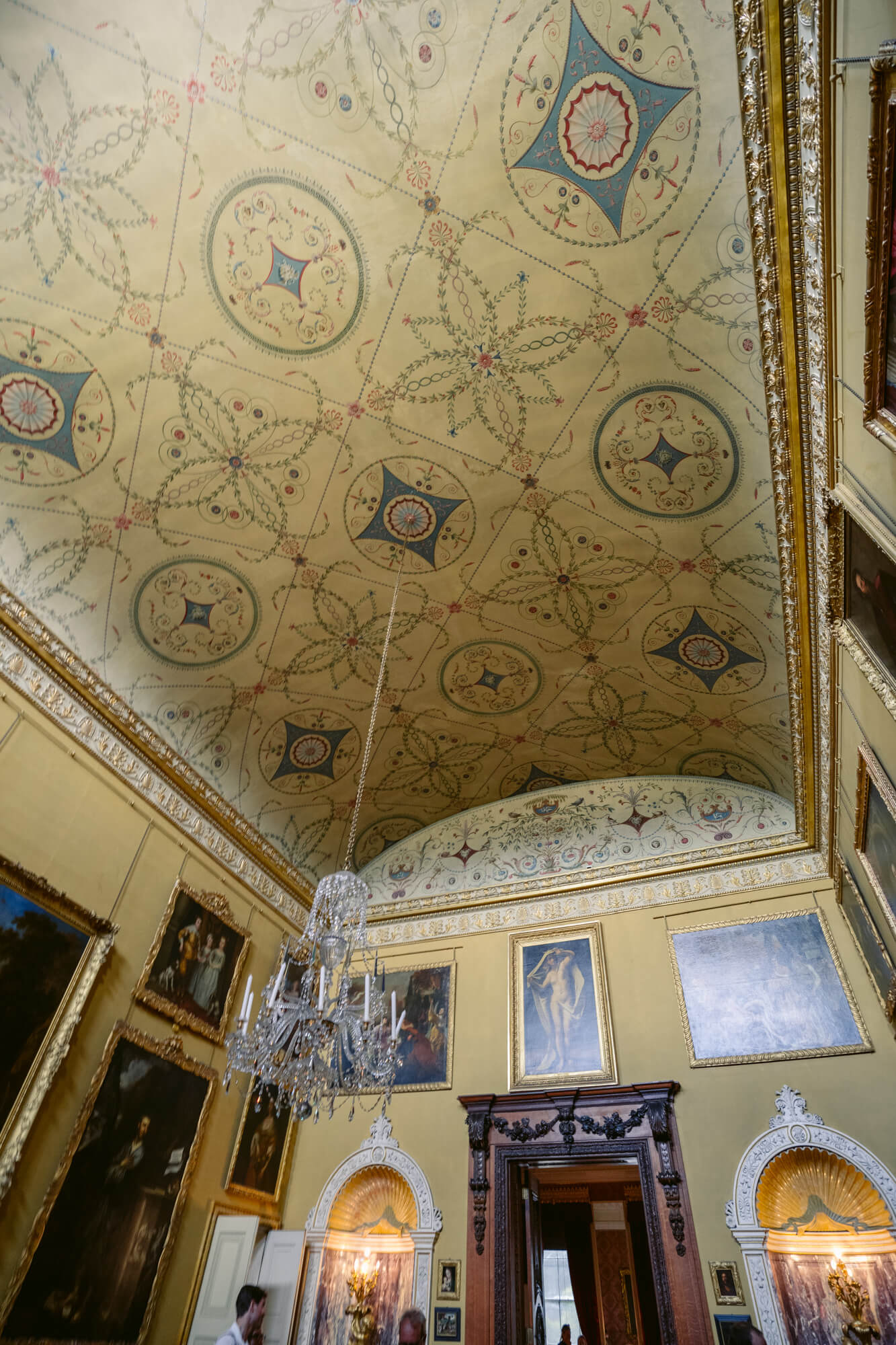
The State Bedroom
This next room is special in that it is the last remaining suite (out of four) on the State Floor. Since 1900, this room has been used more or less as a normal bedroom.
A key highlight of this room is the intricately carved bedstead made of walnut, holly, and sycamore. Designed by William John itself, this detailed piece of work was unfortunately incomplete at the time of his death, although it is said that his brother George was able to nab it at a reduced price as it was incomplete.
Some details to take note of on this bedstead include a relief of Venus, Cupid and Putti, along with the Bankes family coat of arms, and even several bats.
PS: While here, don’t forget to take a peek at the relatively modern-looking ensuite bathroom, which was fitted in 1909 by Henrietta Bankes.
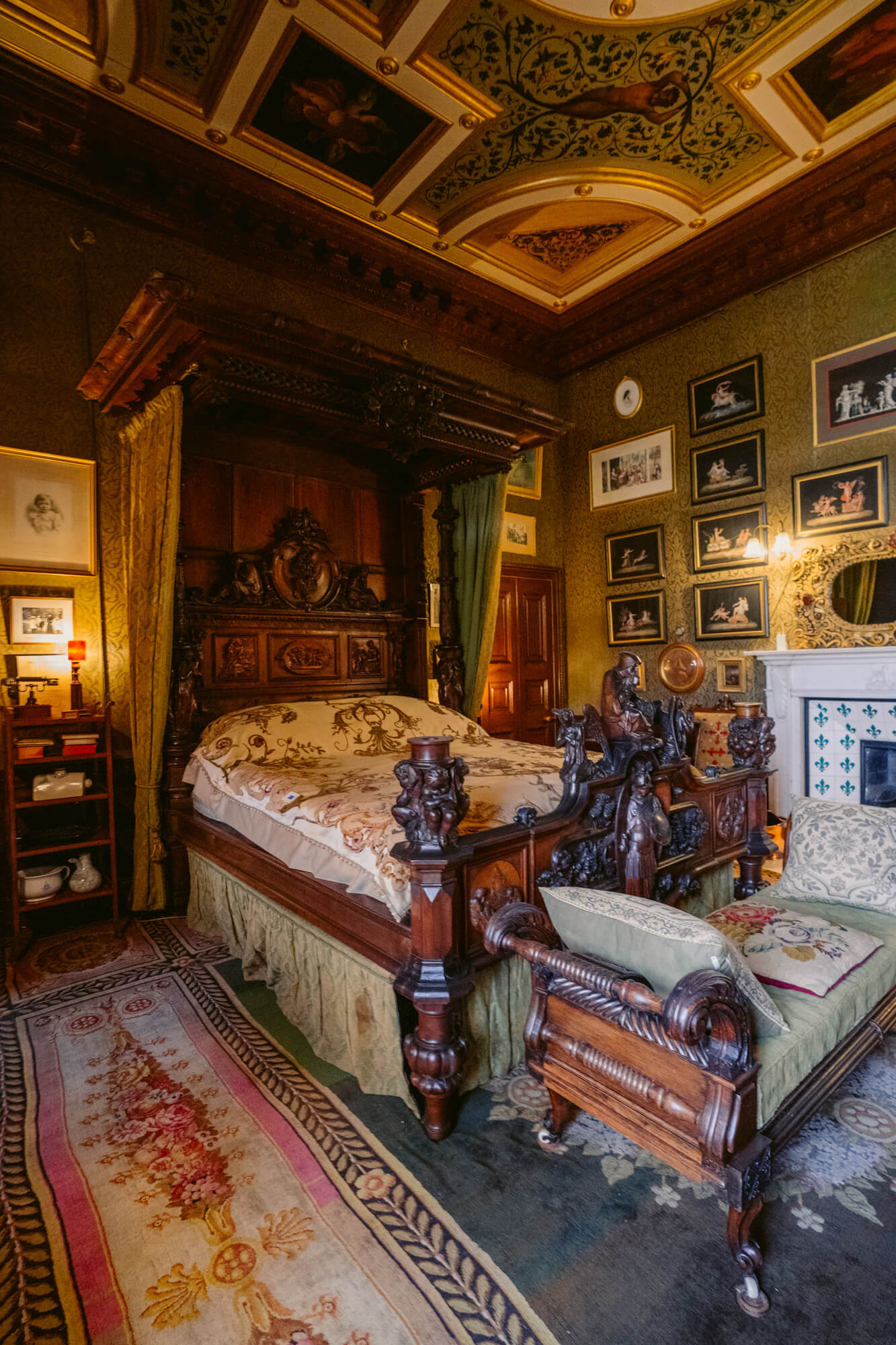
Upper Marble Staircase Landing
Before you head to the final rooms of the tour, one of the most breathtaking sights at Kingston Lacy House awaits: the Upper Marble Staircase Landing, a bright and airy space that William John turned into a showcase for his love of Italian art, from bronze statues made in the likeness of Michlangelo’s work in the Medici Chapel of San Lorenzo Church in Florence to a beautiful Renaissance ceiling painting of cherubs and birds.
As for the stone candelabras on the banisters, those were designed by William John himself, who had them carved in Italy.
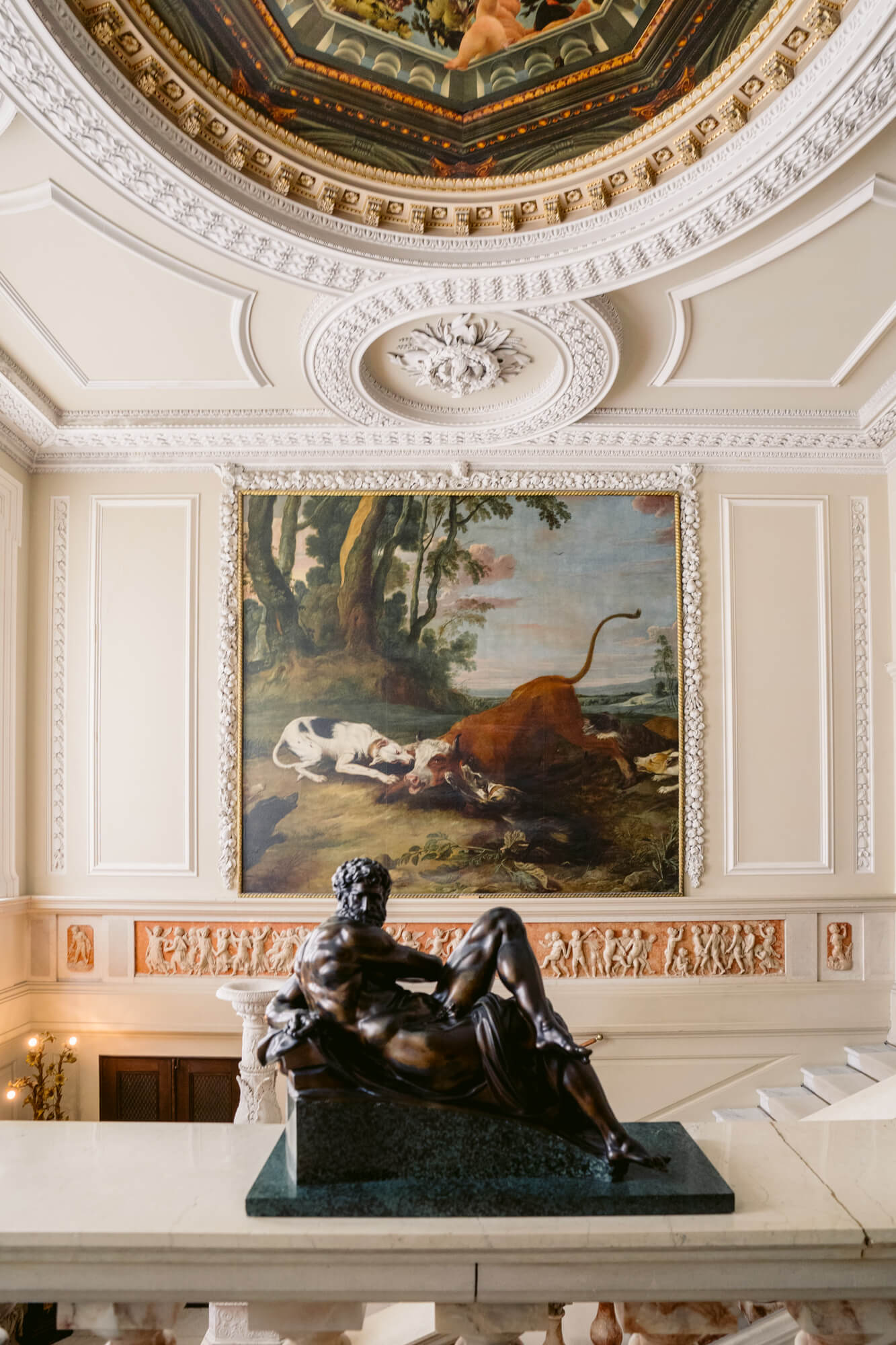
The South East Bedroom
Following the loss of her husband in 1841, William John’s sister Anne returned to the family home and this bedroom became her base at Kingston Lacy.
It is said that William John’s consideration for his sister’s comfort influenced his design decisions a great deal, with him even scrapping plans for raising the ceiling of the Library to accommodate her comfort and wishes.
While charming, it’s important to note that many of the details and decor you see today are merely modern reproductions of the original 19th century designs found in the house before. While the bed and sideboards (made of mahogany) are indeed original, the wallpaper and carpet had to be reproduced due to the immense dry rot that befell the room in the latter half of the 20th century.
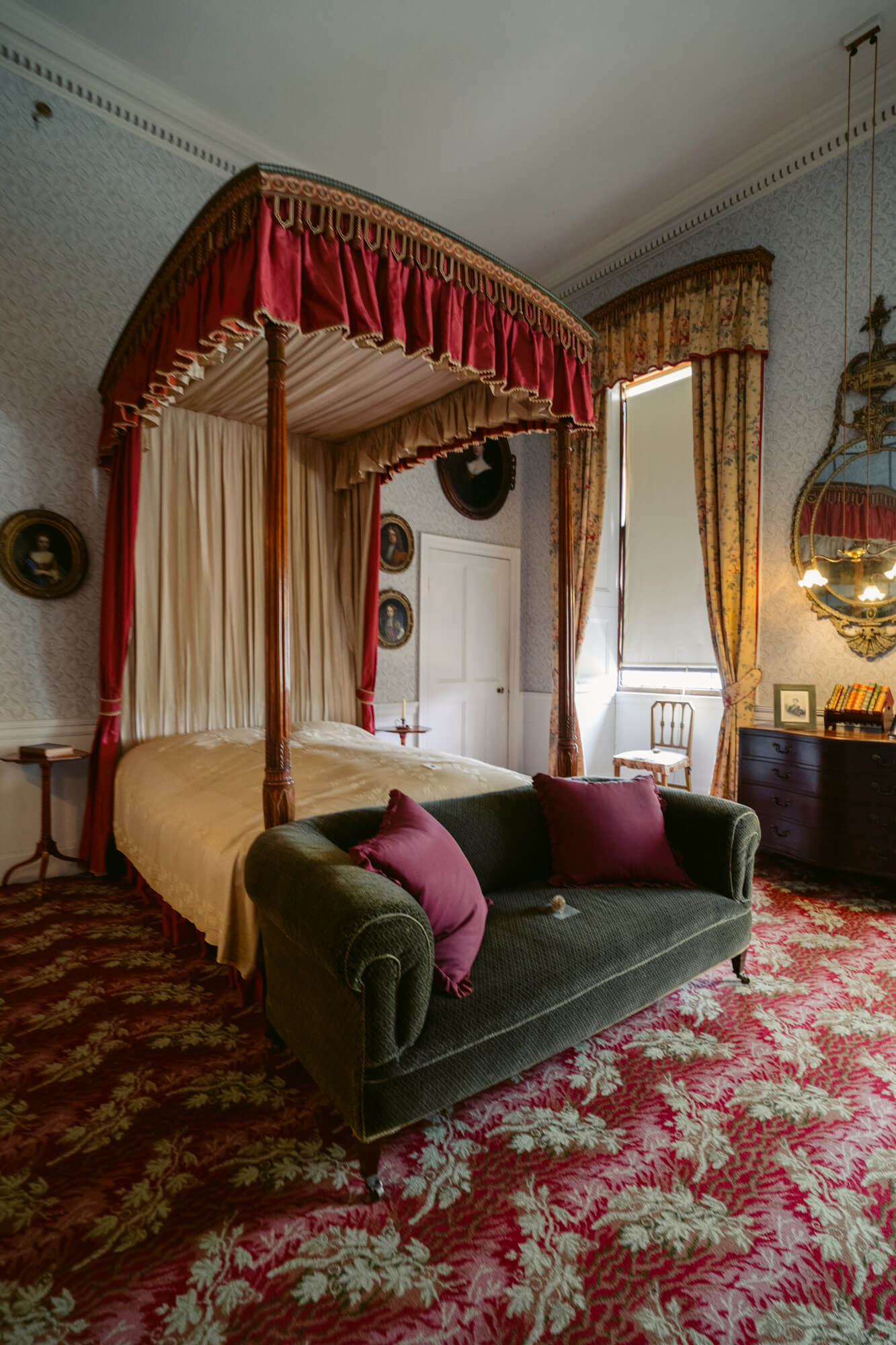
The Attic
Finally, as you make your way up to the top floor, you’ll encounter a few more items from the Kingston Lacy collection on display. During our visit, we got to see an oak panel that is considered one of the oldest religious paintings in England, which dates back to the 14th century.
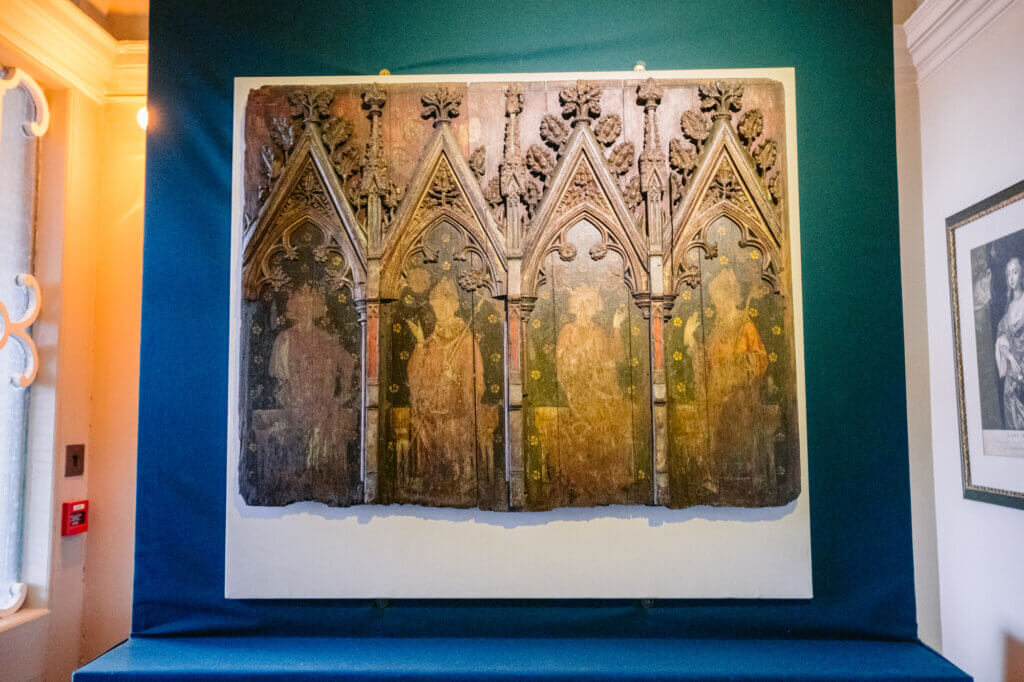
Upstairs, you’ll find a divided space that contains both servants’ living quarters as well as whimsical guest rooms, some of which later became children’s bedrooms in the late 19th century.
A highlight of this floor is definitely the bedrooms designed to look like striped military tents, although a peek at the servants’ rooms and bathroom at the end of the hall are quite interesting as well… as are the family portraits lining the hallway.
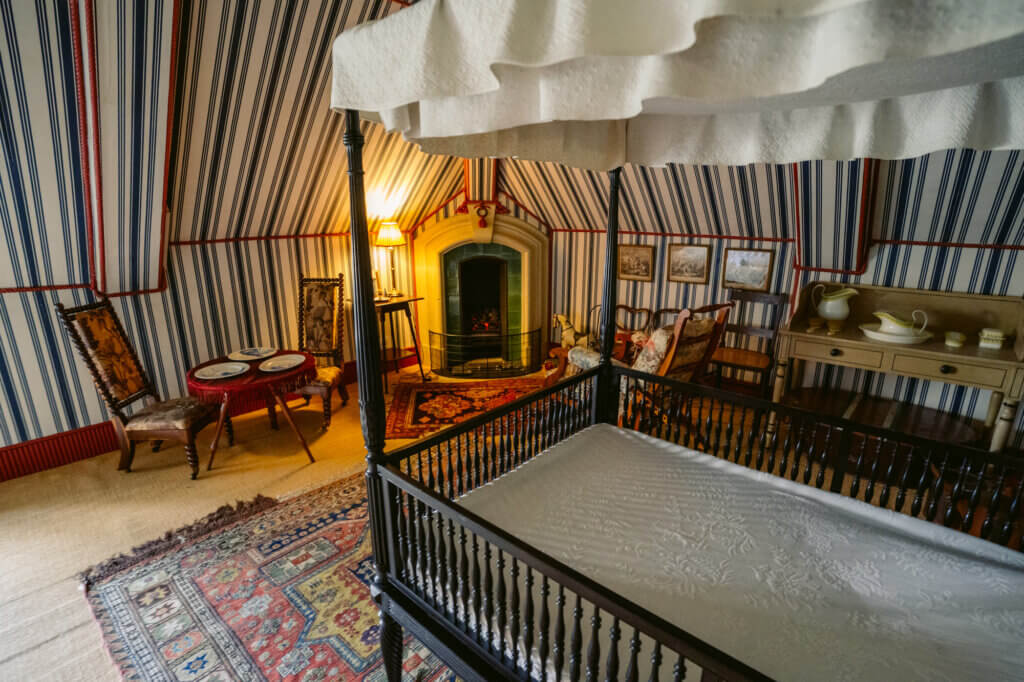
All that said however, our favourite part was possibly the (very modest) linen closet.
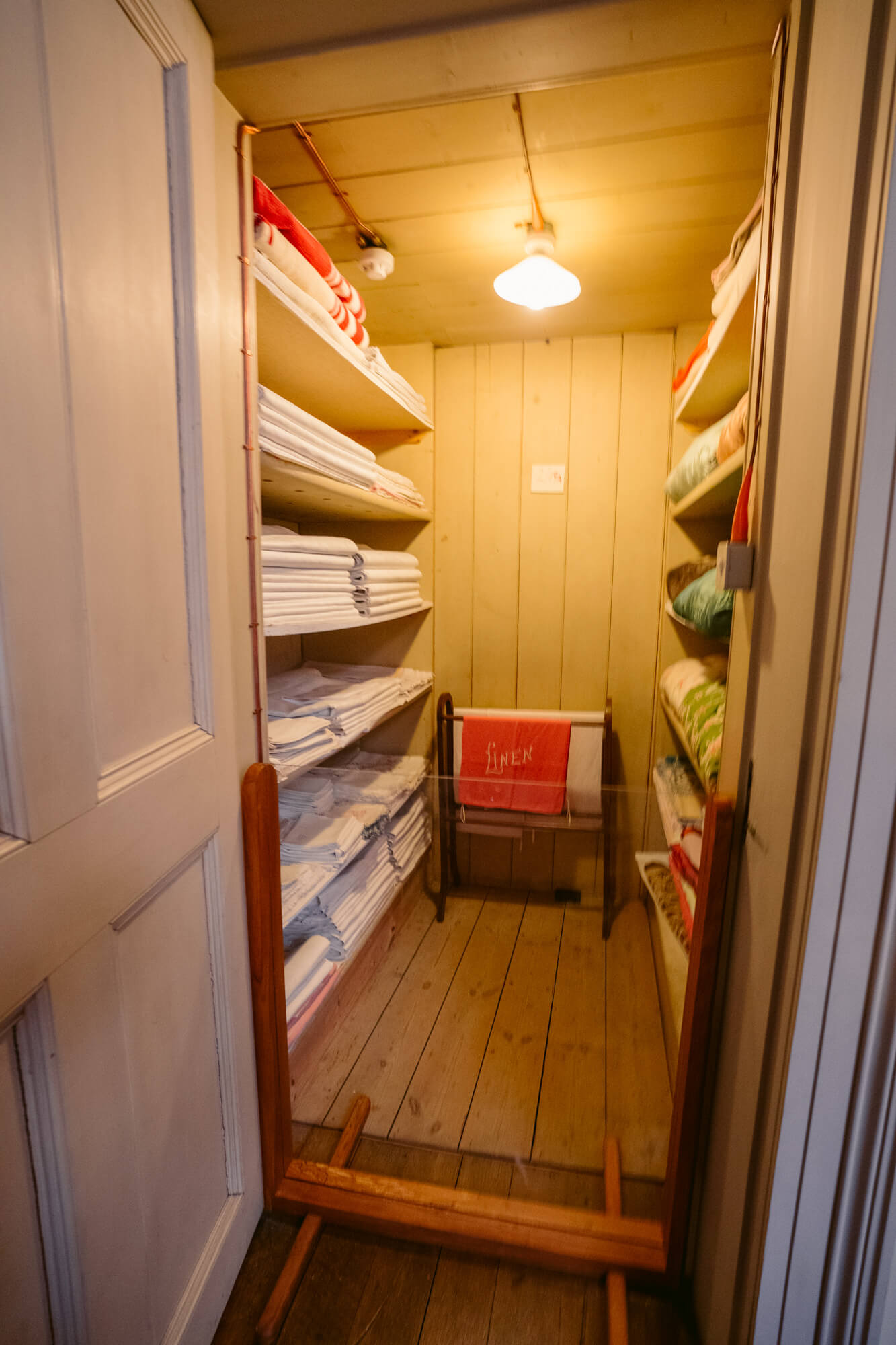
The White Bedroom
On your way back down to the main floor, don’t miss the White Bedroom (unless you already snuck a peek on your way up to the Attic).
Redecorated in 1897 by Henrietta Bankes, this dainty and airy room makes use of French wallpaper and white furniture to create a homey and personal space that’s adorned with family photographs and prints.
Fun fact: the lace bedspread is said to have been repurposed from a wedding veil. Whether it was Henrietta’s or not though is still up for debate.
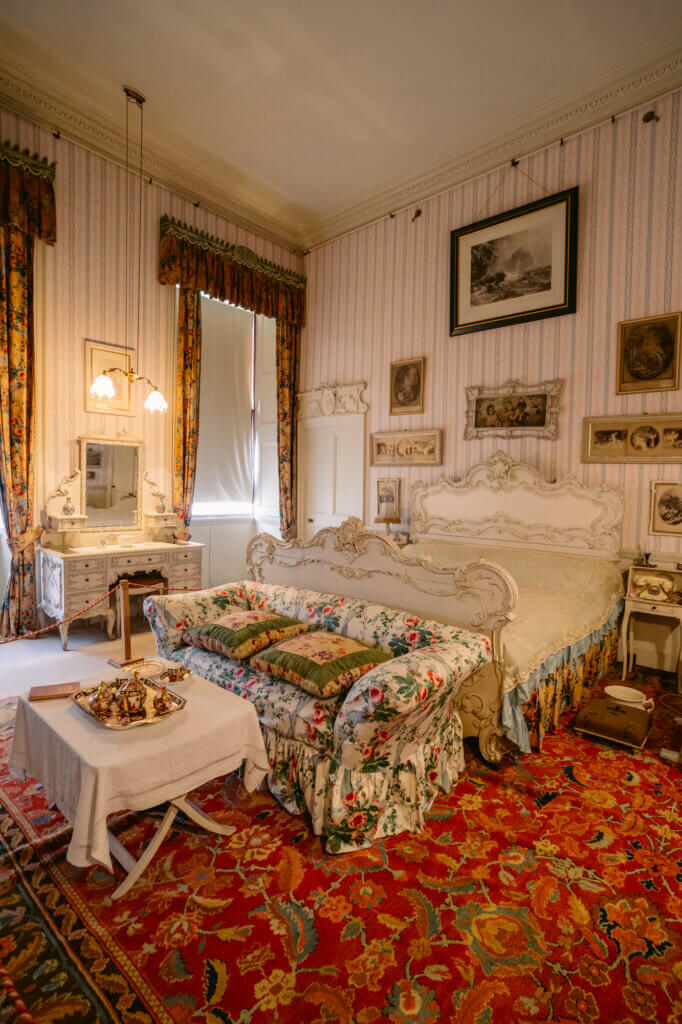
The Servants’ Hall and Back Hall
Lastly, before you leave Kingston Lacy House, you must stop by the Servants’ Hall, which (to us) was one of the most interesting rooms in the building. Take note of the intricate bell system which would show House staff where they were being summoned, and try to imagine what it must have been like to be at the beck and call of the Bankes family over hundreds of years!
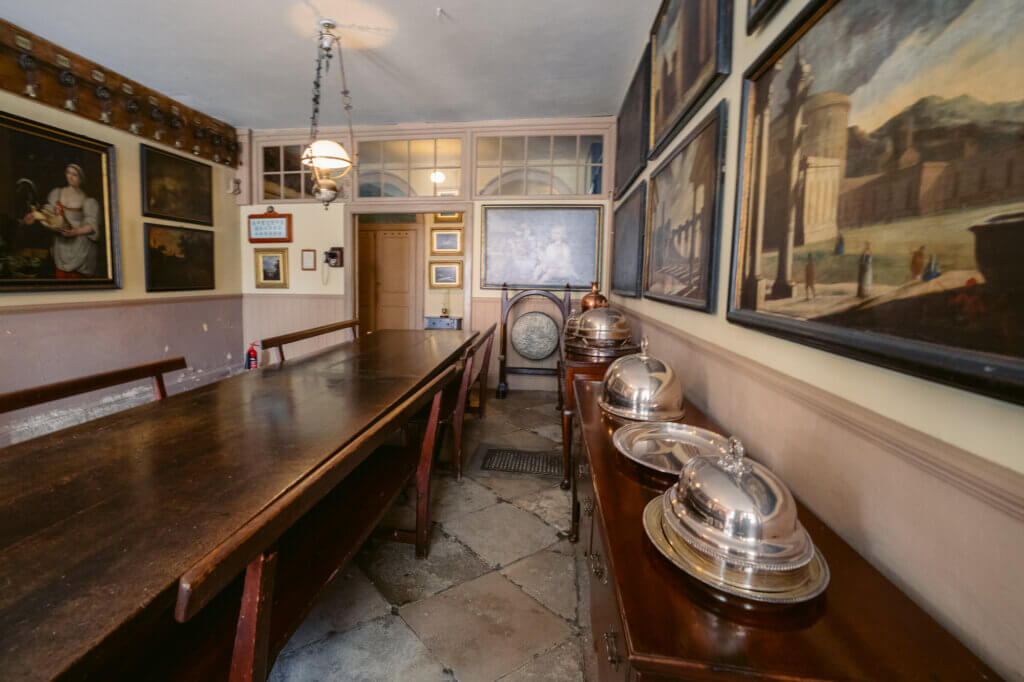
In the final room, you get to admire some of the artefacts that William John took home from his travels in Egypt, part of a collection that some say is the largest private collection of Egyptian artefacts in the country. There is also a computer where you can learn more about the estate’s extensive collection.
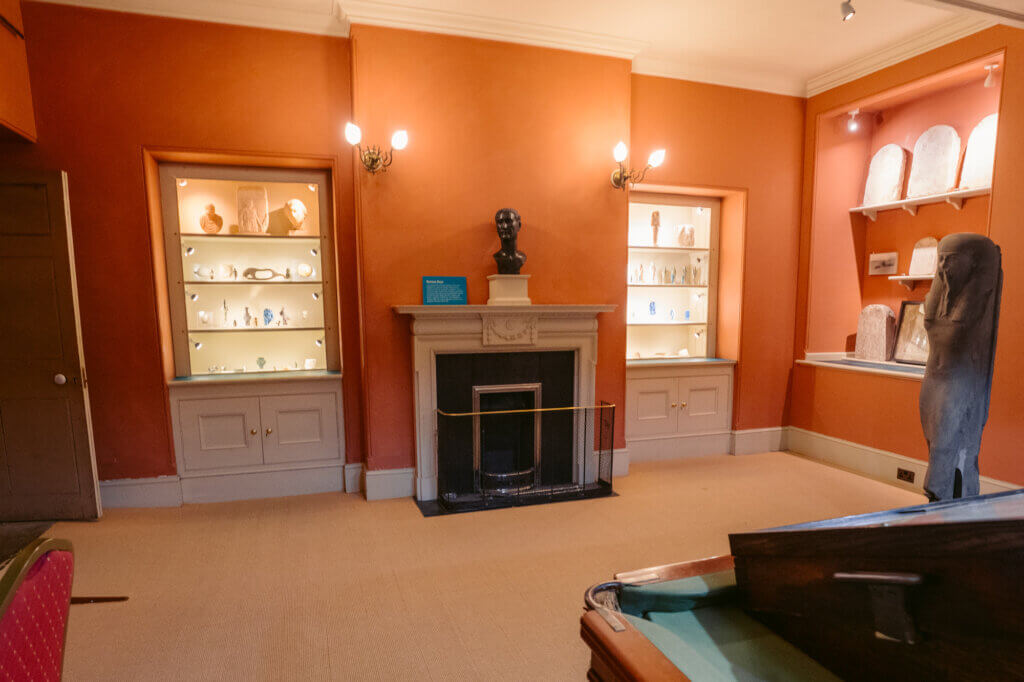
Additional Tips for Visiting Kingston Lacy
What other must-knows should you keep in mind during your trip to Kingston Lacy? Here are a few final tips.
Arrive early to guarantee that you’ll see inside the House
If your main priority at Kingston Lacy is visiting the House, then it’s advisable that you arrive early, as they limit capacity for the House on a first come first serve basis.
Here’s how it works: once you arrive, you will proceed to a National Trust volunteer in/around the Shepard’s Hut, who will hand you a timed ticket for entry, which shows a 15 minute entry time slot.
For example, ours were valid for entry between 1pm to 1:15pm. With this ticket, you proceed to the House during your designated time slot, and then tour the House at your own pace.
NOTE: There’s no time limit on these tickets, so you can stay as long as you like!
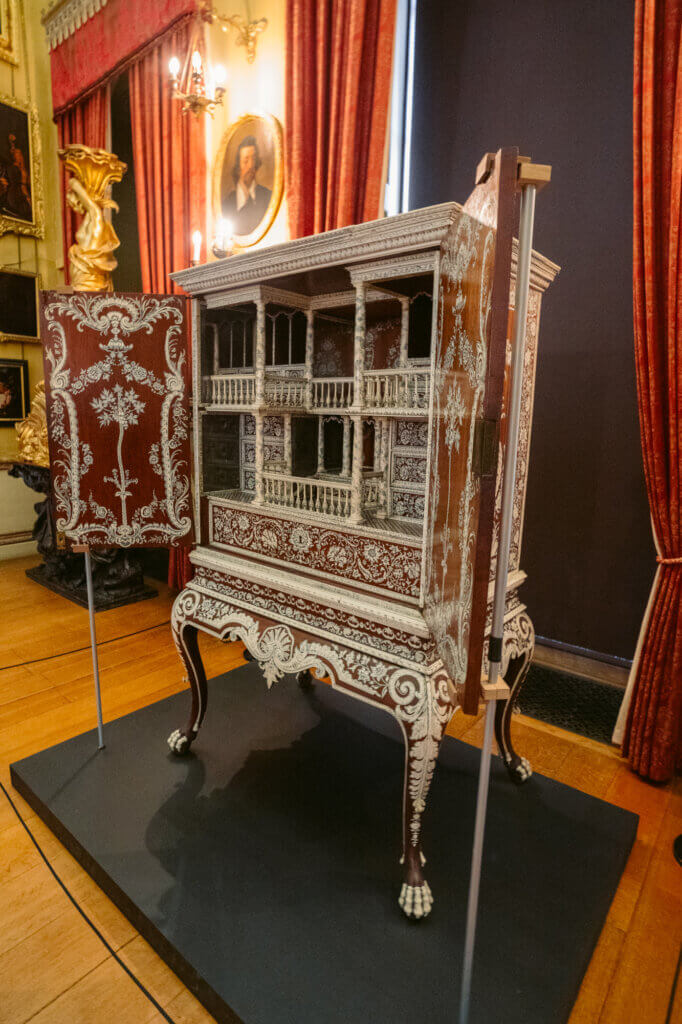
Wear comfortable shoes
The Kingston Lacy estate is massive, so you’ll want to be comfortable as you explore! No high heels here, as glamorous as that might sound.
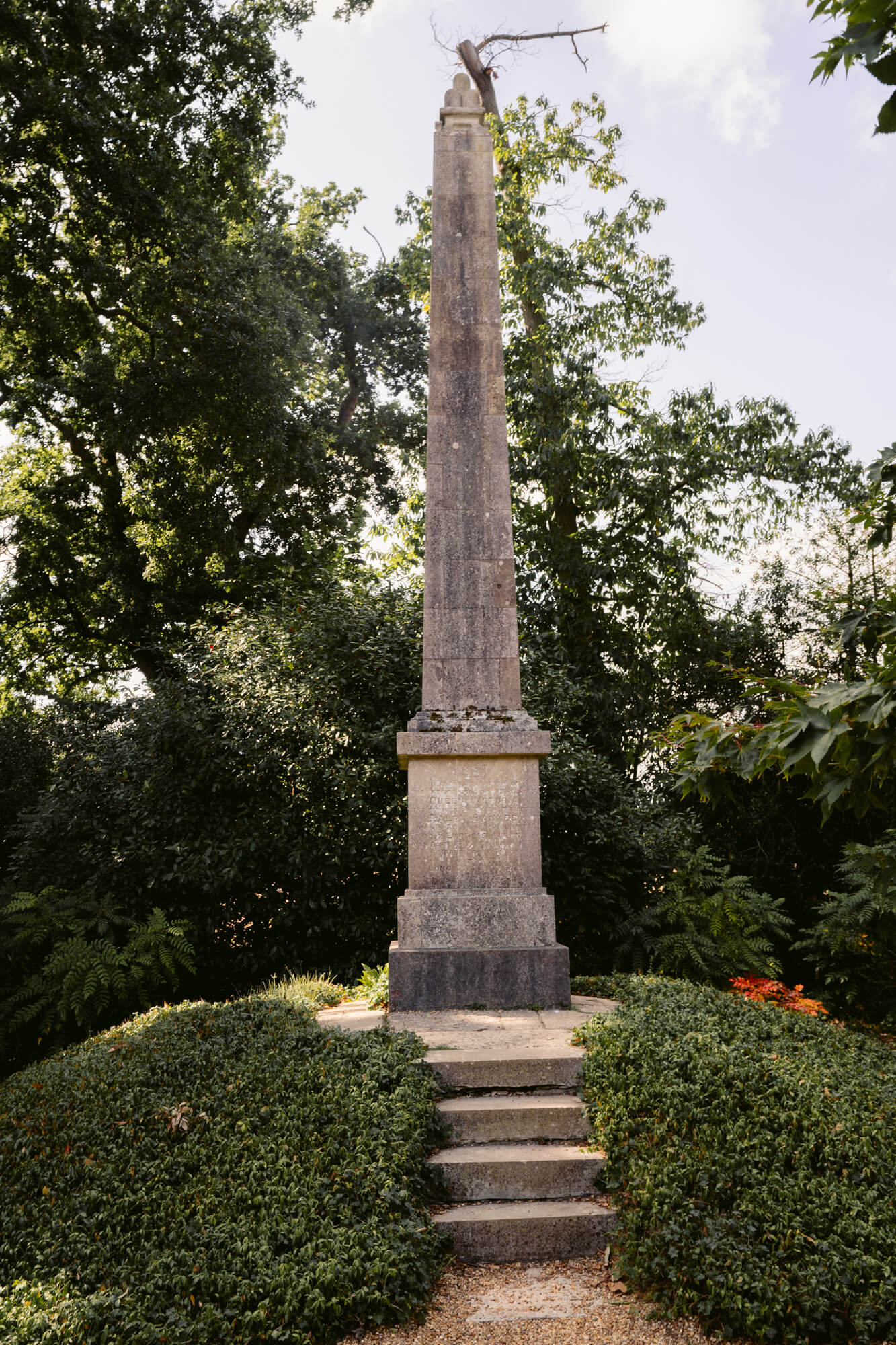
Pack small
Backpacks are allowed in Kingston Lacy House, but you are asked to wear them on your front, so for the most comfortable possible experience, pack small, or leave any larger bags in the car.
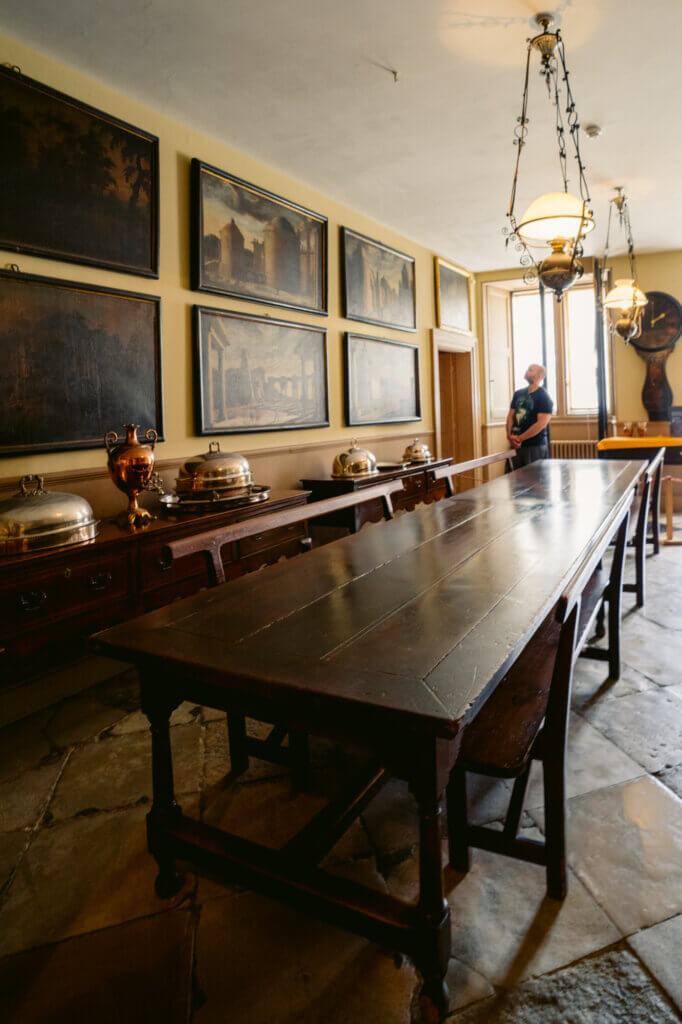
Pack a picnic
There is an on-site restaurant and cafe at Kingston Lacy, but If you want to save a bit of money, then definitely bring some nibbles and drinks to enjoy during your day out.
The estate offers a lot of great areas for picnicking, with some lawn chairs scattered around and even a few wooden picnic tables.
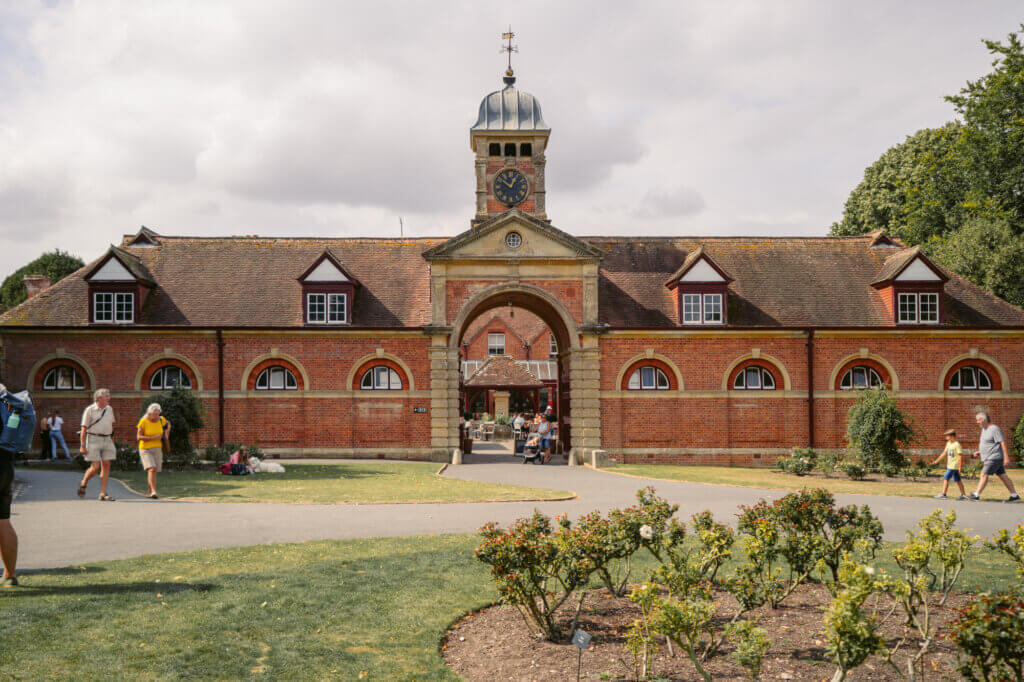
Enjoy some other great spots in the area
Kingston Lacy is located very close to some other noteworthy destinations, like Wimborne Minster, which is a lovely little town with a lot of great pubs and a quirky model village.
Heading South, you could also venture down to Poole or Bournemouth for a nice coastal addition to your day, or perhaps you could drive North up to Shaftesbury, famed for its beautiful Gold Hill (made famous by an iconic bread advert!)
No matter which way you choose to go, there are lots of great places to visit near Kingston Lacy, so be sure to stack a few onto your itinerary for a perfect day.
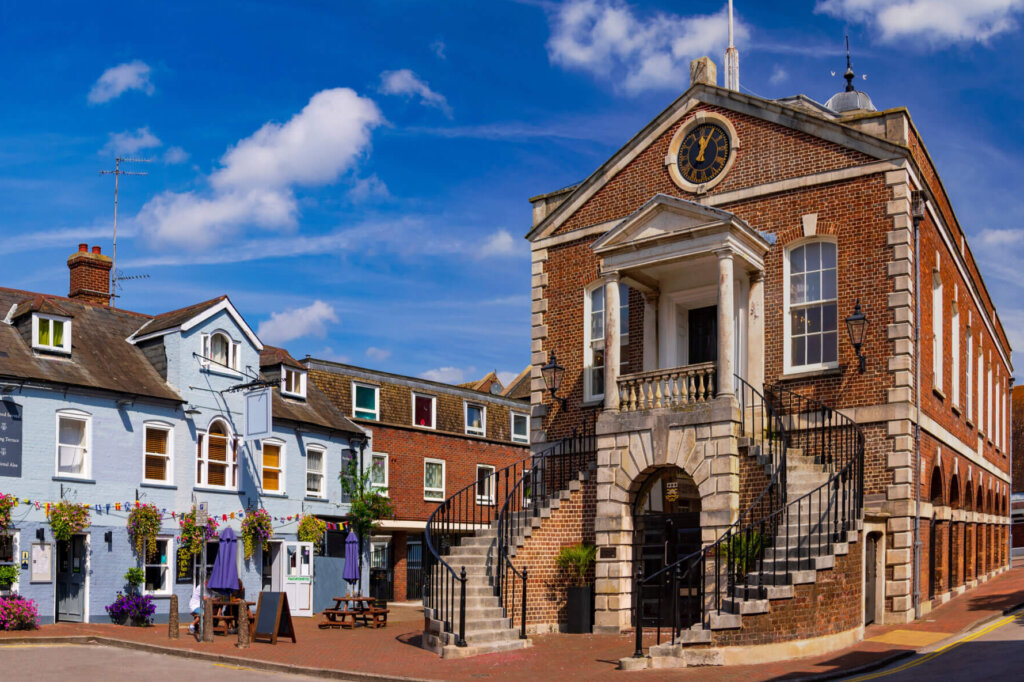
We Hope You Enjoyed This Guide to Kingston Lacy!
Let us know in the comments if you have any more questions, or insider tips to add. We’re always looking to improve our articles for readers!
